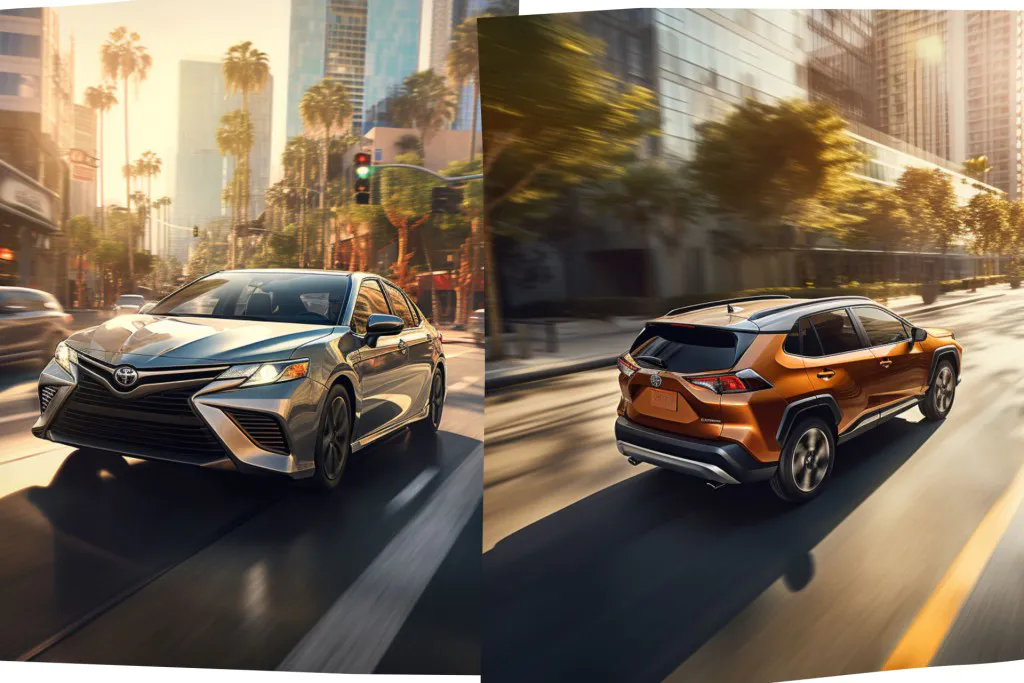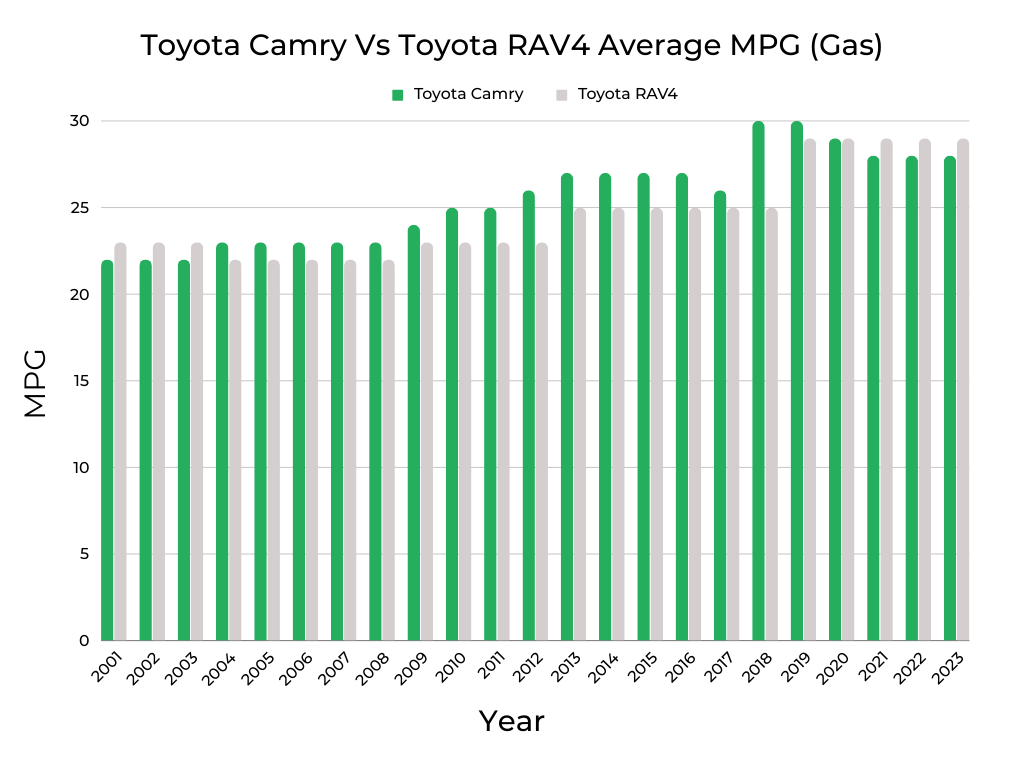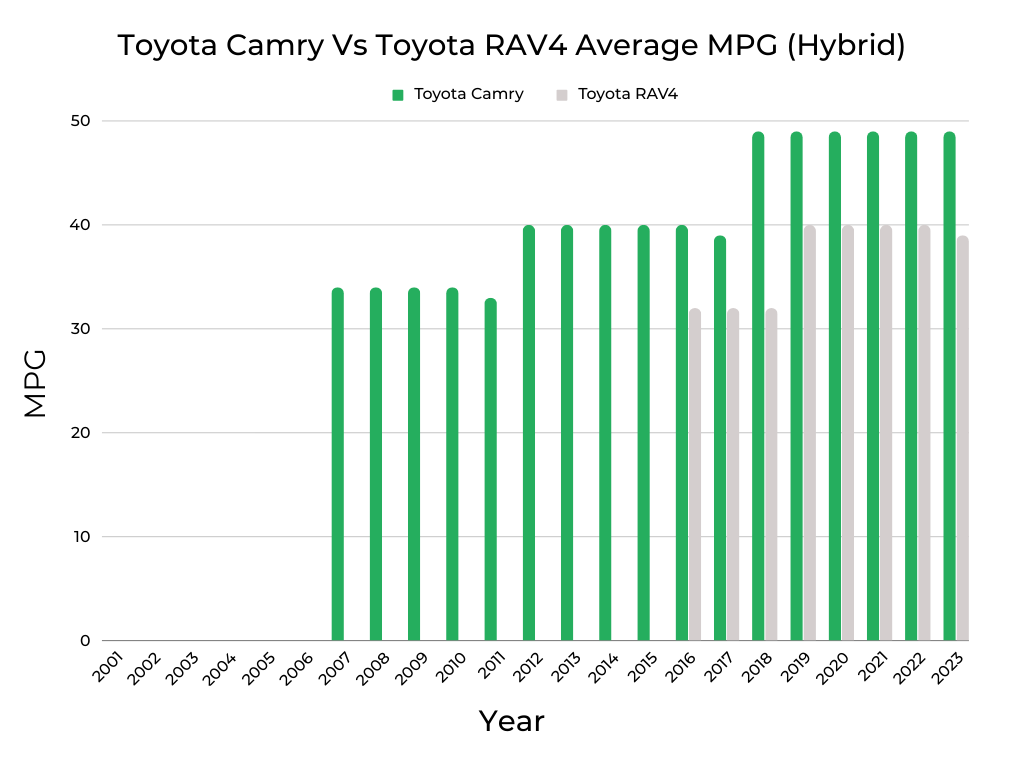| Income Bracket | Monthly Financing Cost Range | Cash Purchase Price Range | Toyota Camry Years | Toyota RAV4 Years | Best Model Year: | Why? |
| <$5k | $42 – $83 | $1,500-$3,000 | N/A | N/A | N/A | Only Camrys from our list of worst model years fit this price range and the cheapest RAV4 starts above $3,000 |
| $5k – $10k | $83 – $125 | $3,000-$4,500 | N/A | N/A | N/A | Both vehicles are on our list of worst model years at this price point |
| $10k – $15k | $125 – $187 | $4,500-$6,750 | 2009 | N/A | 2009 Camry | RAV4s in this price range are all on our list of years to avoid |
| $15k – $25k | $187 – $312 | $6,750-$11,250 | 2012 | 2012 | 2012 Camry | Higher FIXD Reliability Score, lower used purchase price, better fuel economy, and higher safety rating |
| $25k – $35k | $312 – $437 | $11,250-$15,750 | 2018 | 2015 | 2018 Camry | Newer model year, more reliable, cheaper to maintain, lower mileage |
| $35k – $50k | $437 – $625 | $15,750-$22,500 | 2020 | 2018 | 2020 Camry | Top reliability marks, similar market value to RAV4, perfect safety score |
| $50k – $74k | $625 – $925 | $22,500-$33,300 | 2021 | 2021 | 2021 Camry | Perfect FIXD and Owner Reliability Scores, cheaper than the RAV4 |
See the methodology for the table above.
When I’m driving around with my kids, we play a game where they point at a car to see if I can name it. Given the number of years I’ve spent subconsciously filing away every vehicle I see, I almost never fail. This is not a boast, it is to point out that I am full of useless information. Why am I telling you this?
Two regular refrains from the kids during their attempts to trip me up are “Is every car a Toyota?” and “Is every car a Toyota RAV4?” The answer is pretty close to “Yes” as the RAV4 is the 5th best-selling vehicle in 2023 and the Camry is number seven.
The first three places are occupied by the Ford F-150, Chevy Silverado, and Ram 1500 pickups with Tesla taking the 4th spot. This is a long-winded way of pointing out the fact that A LOT of people buy Toyota Camrys and RAV4s.
Though they may not seem like obvious competitors, the Camry and RAV4 share a platform, both offer hybrid powertrains, and both can be fitted with AWD. Sure, sedans are no longer part of the cool kid crowd, but the Camry is an excellent vehicle and for those who subscribe to the SUV-ification of the auto industry, there’s a RAV4 for that.
Hence this comparison aims to give would-be buyers an answer to which Toyota is best in 2023 and which prior model year is the best bet for every budget. On that latter point, the above table gives a quick view of where you can start.
Each row gives the best model year Toyota Camry and best model year RAV4 based on income range, monthly financing costs, and cash purchase price per KBB. We’ve then chosen the best option – Camry or RAV4 – based on those criteria. Hint: The Camry is usually the better bet.
Our deep-dive Best and Worst Model Year series of articles, which cover the Toyota Camry and Toyota RAV4, provide more detail into why the model years listed above make it onto our “Best Of” rankings. But, in a nutshell, we’ve analyzed the data from the thousands of FIXD devices installed in owner’s Camrys and RAV4s to determine objectively reliable and unreliable model years.
That is mashed up with safety scores and recall details from the NHTSA, resale values per Kelley Blue Book (KBB), fuel economy figures published on FuelEconomy.gov, and annual maintenance costs. It’s a whole lot of information that I hope helps you figure out whether to buy a Toyota Camry or a Toyota RAV4.
For more insight into these vehicles, check out our Toyota RAV4 vs. Honda CR-V article and Camry vs. Corolla writeup. Thinking about hitting the classifieds right away? Before you respond to the “For Sale” ad, be sure to read our Used Car Buying Checklist article.
Price History Comparison | Toyota Camry vs. Toyota RAV4
Average Market Value – Based on Owners’ Self-Reported Mileages | Toyota Camry vs. Toyota RAV4
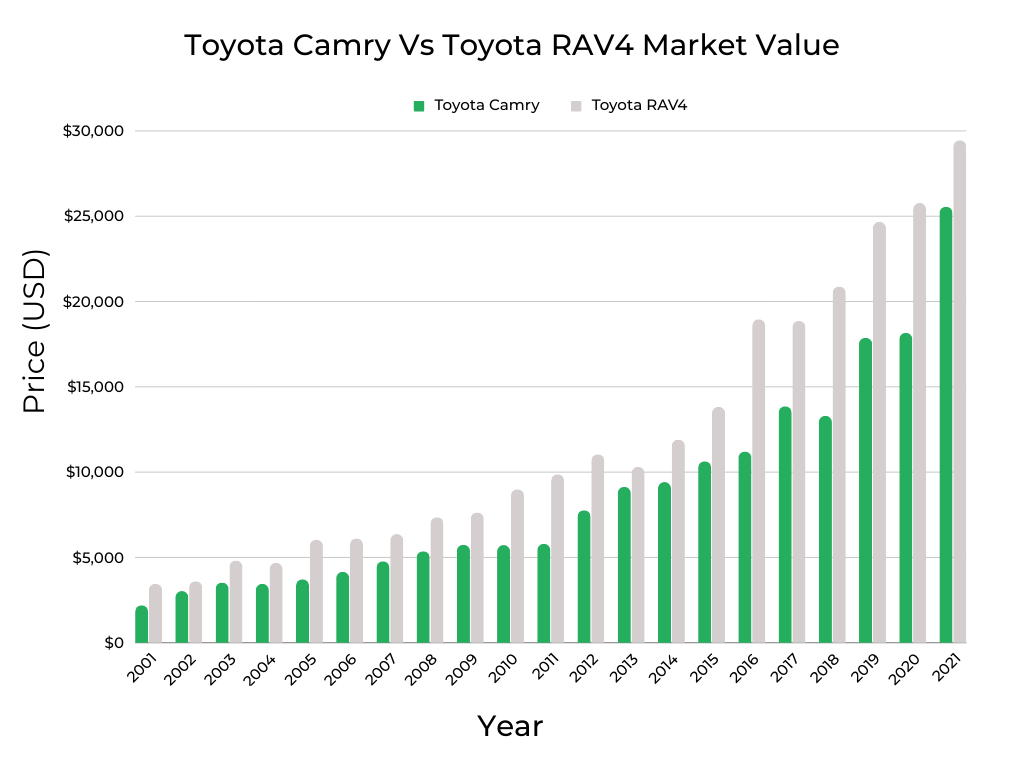
The chart above, Toyota Camry vs. Toyota RAV4 Market Value, is perhaps one of the most important for anyone looking to buy a used Camry or RAV4 as it gives a clear indicator of price points based on current market values from KBB.
As with most vehicles, as time goes on, mileage goes up and prices go down. That’s true here, but what’s interesting is that the Camry (green bars) is consistently less expensive than the RAV4 (gray bars). Going back 20 years, you can see that the RAV4 has historically been more expensive than the Camry and the gap in market value has only increased over time.
For certain model years, like 2011 and 2016, the relatively large separation in values can be explained by mileage. Per FIXD customer surveys, the 2011 RAV4 averages about 110,000 miles while the 2011 Camry comes in at 153,00 miles. For 2016, the differential is even wider at about 60,000 miles.
So, it’s understandable why you would pay more for a RAV4 in 2011 or 2016 as mileage has a significant impact on market value. However, between 2013 and 2020, the value gap widened even though most years don’t have a corresponding mileage gap.
For example, between 2018 and 2020, owner-reported mileage for both Toyotas only differed by 1,000 to 2,000 miles. This makes you – and me – wonder why the RAV4 has become more valuable than the Camry over time. So, I did some digging on how Toyota has priced these vehicles since 2001.
Looking back at MSRP data per KBB, I found that in 2001, a base RAV4 cost $19,175, and a base Camry cost $19,733 – a roughly $550 swing with the Camry as the more expensive option. But, by 2013, the RAV4 carried a base price of $25,560 versus $23,404 for the Camry.
It’s possible that Toyota recognized consumers were placing more value on the RAV4 as far back as 2001 – which KBB values back up – and over time started shifting pricing accordingly. More recently, as the sedan has taken a back seat to the popularity of SUVs, we can see that the RAV4 has become significantly more valuable and a 2023 RAV4 is still about $2,000 more than a 2023 Camry across the board.
What does that mean for anyone cross-shopping these two Toyotas? Well, the savvy buyer would ignore the hype that SUVs are somehow “better” than sedans and find themselves a used Camry to save significant money over a used RAV4 – especially over the past 6 model years.
While shopping, keep in mind that “mileage matters”, meaning a high-mileage vehicle that has been primarily used for long highway drives is not necessarily worse than a low-mileage option that has mostly been driven around town in stop-and-go traffic.
On that note, be sure to check out our Best and Worst Model Year articles on the Toyota RAV4 and the Toyota Camry for a more in-depth analysis of each vehicle.
Depreciation vs Maintenance Expenses
Depreciation is the silent enemy of naive new car buyers, but the quiet friend of savvy used car shoppers. Why? Because after just one year of ownership, a new car loses in the neighborhood of 10 to 15% of its value. After 5 years, depreciation takes a nearly 50% bite out of the original sticker price.
Certainly, as a car gets older, wear and tear takes a toll, and repair costs can increase. However, there is a sweet spot in the battle between depreciation and maintenance costs that we’ve illustrated for you in the graphs above.
As indicated by the black box on each chart, you can see that the 2005 to 2013 Camry and 2004 to 2009 RAV4 occupy this Goldilocks zone of used car buying. Not TOO many miles and not TOO expensive to maintain, these respective model year ranges are JUST right.
Interestingly, these depreciation charts bolster our comment from the market value section above that you can save money by looking for a Camry instead of a RAV4. The green line on these depreciation charts illustrates the average maintenance costs per mile of driving.
That metric ranges from about 5 to 10 cents per mile for the 2004 to 2009 RAV4, but for the 2005 to 2013 Goldilocks Camry zone, it ranges from about 3.5 cents to 9 cents per mile. Not only that, the Camry’s sweet spot captures more model years than the RAV4 meaning would-be buyers will have a larger pool of vehicles to choose from.
You can go deeper on this exciting topic with our Toyota Camry Depreciation Rate & Curve article.
Reliability Comparison | Toyota Camry vs. Toyota RAV4
Bolstering the trend of the Toyota Camry offering a better overall value than its RAV4 platform-mate is the FIXD Reliability Score comparison chart above. Over 21 years, the Camry has objectively higher reliability than the RAV4 11 of those years, or more than 50% of the time.
The RAV4 only bests the Camry’s FIXD score 4 times out of 21, leaving 6 other model years where these Toyota’s are even when it comes to data-driven reliability. Notably, all 4 of the years that the RAV4 pulls ahead – 2002, 2013, 2018, and 2021 – land on the right side of our best and worst RAV4 rankings.
Of the 11 years that the Camry is more reliable than the RAV4, only 5 come from the “best of” side of our Camry model year ranking analysis, specifically the 2008, 2012, 2014, 2016, and 2020 model years. So while visually, the 2004-2006 Camry is far more reliable than the RAV4 over that stretch, the 2006 Camry is not recommended by us due to poor reliability against the rest of the Camry lineup.
The chart next to the FIXD Reliability Score comparison shows what owners think of their Toyotas and in this case, it’s a closer competition. This chart is based on subjective survey data, but it is relevant as it illustrates how highly owners value their Camrys and RAV4s.
From 2005 onward, neither vehicle scores below 6 out of 10 for this owner-reported score, and the 2021 Camry – which beats out the 2021 RAV4 on best model year for the budget – scores a perfect 10. Bottom line – owners love their Toyota Camrys and RAV4s with nearly equal enthusiasm.
Longevity Comparison | Toyota Camry vs. Toyota RAV4
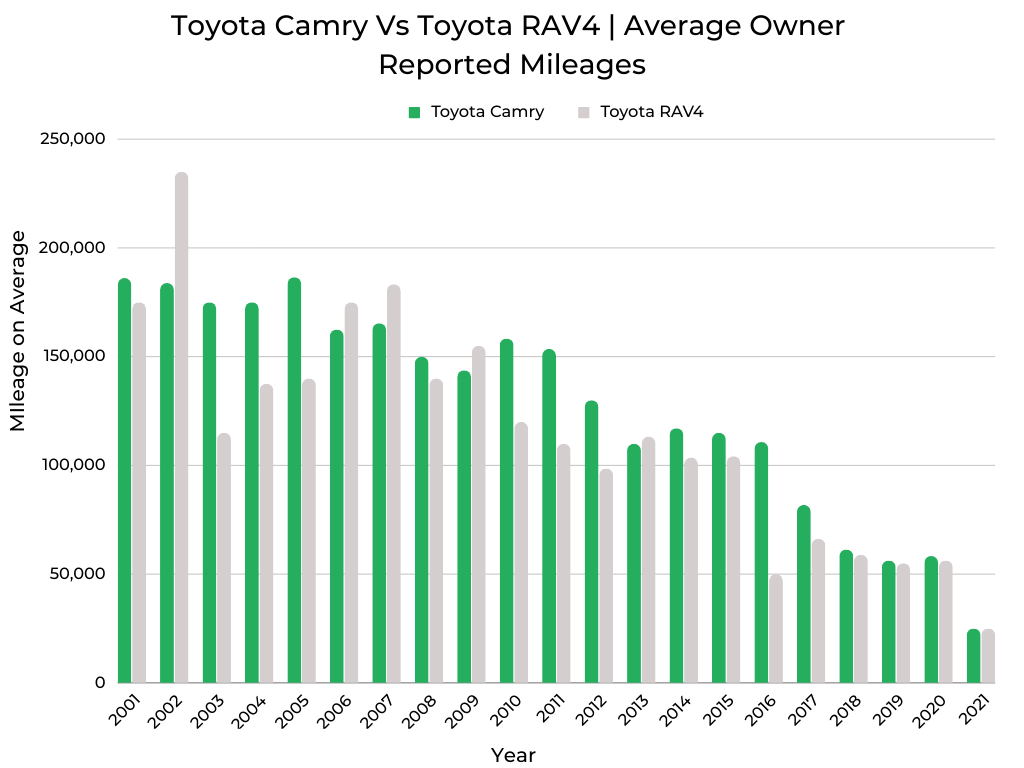
Correlating to the section above that compared the reliability of these two vehicles, the Camry has higher odometer readings – per owner survey data – than the RAV4 in 15 of the 21 model years represented on the chart above.
That’s more than 70% of the time and makes sense in context with the reliability comparison – a more reliable vehicle is likely to rack up more miles as it will spend less time being repaired. And the Camry has no problem racking up those miles as every model year from 2016 and back has at least 100,000.
Naturally, the older a car gets and the more miles it accumulates, the lower its market value becomes. The hook of course is the potential for bigger repair bills. Fortunately, if you’re in the market for a used Camry, you can confidently shop for the 2009 or 2012 model year with less stress on this topic.
Both also get a thumbs up on our ranking of best and worst model years of the Camry.
This doesn’t mean the RAV4 is altogether worse, but only the 2009 model year falls in the Goldilocks zone and lands on the right side of our Best and Worst Model Years of the RAV4 rankings And as you can see on the chart above, this is one year the RAV4 has higher mileage than the Camry, while simultaneously costing more on the used market.
2023 Toyota Camry vs. Toyota RAV4 | A Guide to Trim Levels & Optional Features
Trim Levels: Starting Prices
If there’s one thing the tables below point out, it’s that Toyota has a 2023 Camry and 2023 RAV4 for just about any need. However, the RAV4 starts about $2,000 higher and stays out in front for the most part.
While the trim names – like XLE – aren’t exact replicas of content between these Toyotas, we can see that the top-tier RAV4 with a traditional hybrid powertrain – the Hybrid Limited – costs some $5,000 more than the highest-end Camry XSE Hybrid.
If you’re interested in value, you should know both hybrid vehicles use the same powertrain – though it makes 11 more horsepower in the RAV4 and is rated for 12 more MPG combined in the Camry version – while sharing notable cabin amenities and advanced driver aids. The RAV4 Limited Hybrid does come with AWD, but is it worth $5,000 over the Camry?
The Prime nameplate used by the RAV4 indicates the use of a plug-in hybrid (PHEV) powertrain, which is unavailable on the Camry and significantly more expensive to access. The main distinction with these models is that you can drive about 40 miles using just electricity.
Other notable variants that distinguish each vehicle are the $33,385 Camry TRD and the $37,895 RAV4 TRD Off-Road. This racy Camry comes with a potent V6 engine, which the 2023 RAV4 doesn’t offer. However, the RAV4 in Off-Road spec can, well, go off-road – something the Camry isn’t exactly known for.
So, as ever, price sensitivity varies by individual and both the 2023 Camry and RAV4 offer staggering levels of features and technology. But, the Camry generally offers that for less.
| 2023 Toyota RAV4 Model | Starting Price |
| LE | $28,275 |
| XLE | $29,785 |
| XLE Premium | $32,675 |
| Adventure | $34,470 |
| TRD Off-Road | $37,895 |
| Limited | $36,580 |
| Hybrid LE | $31,225 |
| Hybrid XLE | $32,735 |
| Hybrid Woodland Edition | $34,025 |
| Hybrid XLE Premium | $35,625 |
| Hybrid SE | $33,920 |
| Hybrid XSE | $36,885 |
| Hybrid Limited | $39,530 |
| Prime SE | $43,090 |
| Prime XSE | $46,960 |
| 2023 Toyota Camry Model | Starting Price |
| LE | $26,320 |
| SE | $27,860 |
| SE Nightshade Edition | $28,860 |
| XLE | $31,070 |
| XSE | $31,620 |
| TRD | $33,385 |
| XLE V6 | $36,195 |
| XSE V6 | $36,745 |
| LE Hybrid | $28,655 |
| SE Hybrid | $30,190 |
| SE Hybrid Nightshade Edition | $31,190 |
| XLE Hybrid | $33,545 |
| XSE Hybrid | $34,095 |
2023 | Toyota Camry vs. Toyota RAV4 | Specifications | Safety, Interior and Exterior Features
For a comprehensive comparison of the Toyota Camry and RAV4, we need to explore each vehicle’s specifications, which are outlined below.
Vehicle Class & Body Style:
According to the U.S. Environmental Protection Agency, the Toyota Camry is a mid-size sedan and the Toyota RAV4 is a crossover SUV. These classifications are based on passenger volume and cargo space.
It’s worth noting that while the RAV4 has more cargo space than the Camry – 40 vs 15 cubic feet – the Camry matches the RAV4 for rear legroom, while edging it out in the front legroom and overall passenger volume metrics.
| 2023 Toyota Camry | 2023 Toyota RAV4 | |
| Class | Mid-Size Sedan/Hatchback | Crossover SUV |
| 4-Door Sedan | LE, XLE, XLE V6, SE, SE Nightshade Edition, XSE, XSE V6, TRD, LE Hybrid, SE Hybrid, SE Hybrid Nightshade Edition, XLE Hybrid, XSE Hybrid |
|
| 4-Door SUV | Hybrid LE, Hybrid XLE, Hybrid Woodland Edition, Hybrid XLE Premium, Hybrid SE, Hybrid XSE, Hybrid Limited LE, XLE, XLE Premium, Adventure, TRD Off-Road, Limited, LE, XLE, XLE Premium, Adventure, TRD Off-Road, Limited |
Powertrain:
Engine Options & Specifications:
For most models of both the 2023 Toyota Camry and Toyota RAV4, a shared 2.5L inline-4 making 203 horsepower provides motivation. In the Camry, this motor is good for a 7.5-second run to 60 mph and 31-32 MPG combined depending on the trim line.
On 2023 RAV4s with this setup, the 0-60 mph sprint takes 8.3 seconds, combined fuel efficiency ranges between 28 and 30 mpg, and due to a smaller gas tank, the RAV4 can go about 423 miles when full versus nearly 500 in the Camry.
Both Toyotas also share a hybridized version of this powertrain that makes 11 more horsepower in the RAV4. But this efficiency-minded setup is far more efficient in the Camry offering up to 52 mpg combined versus 40 mpg combined, which is the best a RAV4 hybrid can muster.
However, only the RAV offers a PHEV powertrain and with it, you can drive up to 42 miles on electricity alone. This moves the needle on fuel economy significantly as these Prime models are rated for 94 MPGe. Also, the RAV4 can tow between 1,500 and 3,5000 pounds depending on the model versus the Camry which is not rated for towing anything.
The other main powertrain difference between these two Toyotas is the available 3.5L V6 in the Camry. Not offered in the RAV4, this motor boasts just over 300 hp and can move the TRD model to 60 mph in a quick 5.6 seconds.
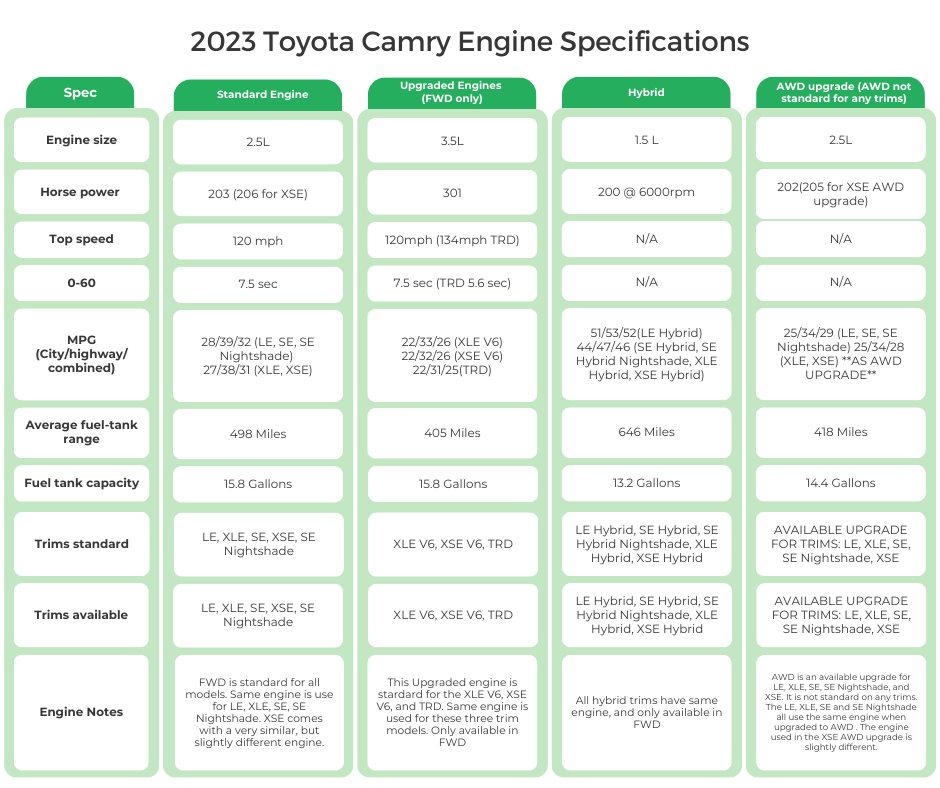
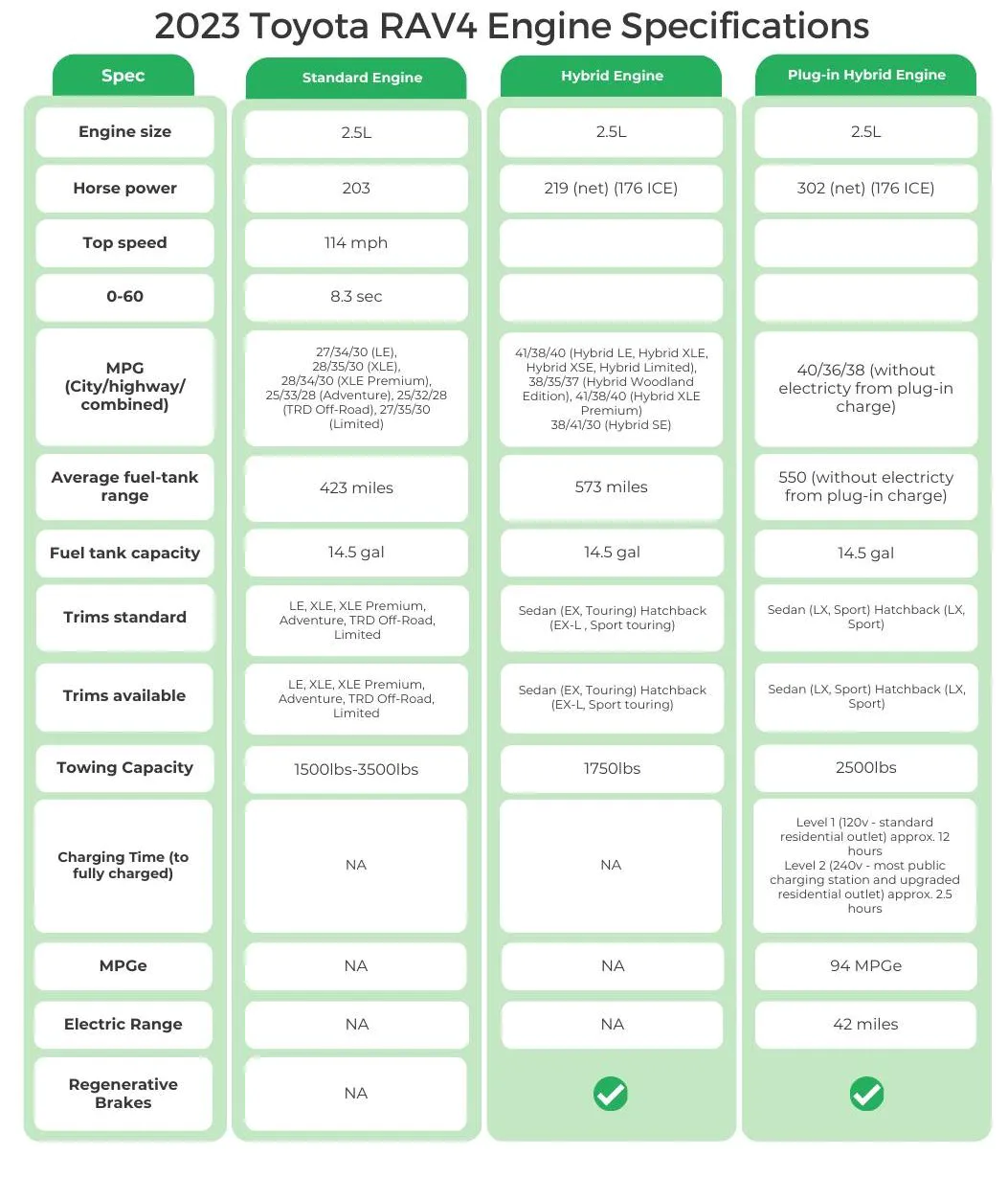
Transmission Options & Specifications:
Toyota makes it easy to compare its 2023 Camry and RAV4 from a transmission perspective. If you buy a gas-powered model of either vehicle, the transmission is a traditional automatic with 8 speeds. Hybrid variants – traditional and PHEV – work with an electronically-controlled CVT transmission.
You can learn more about the differences between automatics and CVTs in the “Tech Talk” section below, but one noticeable difference is that Toyota offers paddle shifters with its 8-speed automatic. So, if you fancy channeling your inner Mario Andretti, the non-hybrid models are for you.
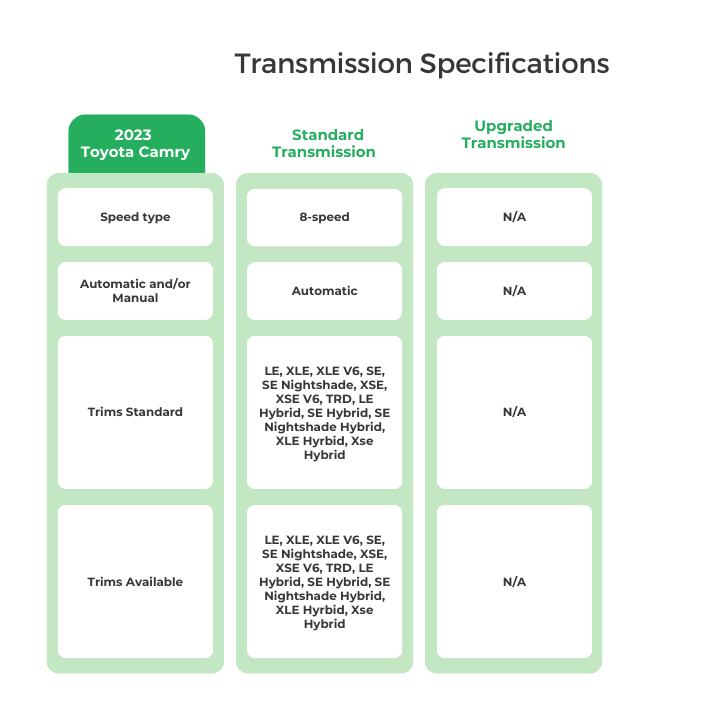
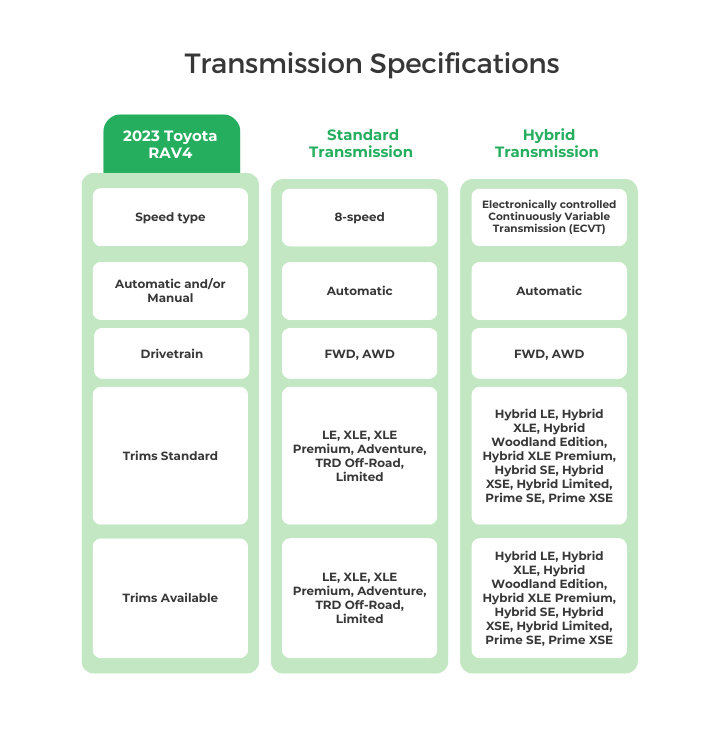
TECH TALK: CVTs
A continuously variable transmission (CVT) does not use gears like a typical automatic transmission. Instead, it has two pulleys connected by a belt. One pulley connects to the engine, and the other connects to the wheels. The belt transfers the power between the pulleys. This setup allows the pulleys to continuously change positions as needed. The CVT automatically adjusts the pulleys as required, providing smooth and efficient power delivery.
An electronic continuously variable transmission (eCVT) uses electronic controls and electric motors to vary gear ratios instead of a belt and pulley system. Unlike a regular CVT, an eCVT has no physical pulleys or belts—the gear ratio is adjusted seamlessly by controlling the speeds of electric motors and generators. This electronic control allows faster, smoother gear ratio changes compared to a traditional CVT. An eCVT also provides more flexibility, needing less space and having fewer moving parts.
Wheel Drive:
As you might expect given it’s an SUV, the Toyota RAV4 is more widely available with all-wheel-drive (AWD) than its sedan-stablemate Camry. All hybrid RAV4s come standard with AWD and the off-road-focused variants feature an upgraded system with the ability to disconnect the rear driveline.
On the other hand, front-wheel-drive (FWD) is standard across the Camry lineup and AWD is only available on 5 of its 13 trim lines, none of which are hybrids.
| 2023 Toyota Camry Wheel Drive | FWD | AWD | RWD |
| LE | S | U | |
| LE Hybrid | S | ||
| SE | S | U | |
| SE Nightshade Edition | S | U | |
| SE Hybrid | S | ||
| SE Hybrid Nightshade Edition | S | ||
| XLE | S | U | |
| XLE Hybrid | S | ||
| XSE | S | U | |
| XSE Hybrid | S | ||
| TRD | S | ||
| XLE V6 | S | ||
| XSE V6 | S |
U = Available in upgrade
E = electric on-demand AWD
D = AWD with rear driveline disconnect
| 2023 Toyota RAV4 Wheel Drive | FWD | AWD | RWD |
| LE | S | U | |
| XLE | S | U | |
| XLE Premium | S | U | |
| Adventure | D | ||
| TRD Off-Road | D | ||
| Limited | S | U(D) | |
| Hybrid LE | E | ||
| Hybrid XLE | E | ||
| Hybrid Woodland Edition | E | ||
| Hybrid XLE Premium | E | ||
| Hybrid SE | E | ||
| Hybrid XSE | E | ||
| Hybrid Limited | E | ||
| Prime SE | E | ||
| Prime XSE | E |
Safety:
NHTSA Safety Ratings:
Safety is likely a priority for anyone buying a car, but perhaps doubly so for those who use their vehicle primarily for family transportation. According to FIXD owner survey responses, both the Toyota Camry and RAV4 are family vehicles first and foremost.
The second-most likely use of these vehicles per owners is for long commutes and traveling. The point is, you’ll want vehicles that are safe when using them for commuting or family shuttling and you really can’t go wrong with the Camry or RAV4 on that front.
Both have 5-star overall crash-test ratings from the NHTSA, but only the Camry earns 5 stars for all the individual test protocols – frontal crash, side crash, and rollover. The RAV4 has 5 stars for side crash-testing, but only 4 stars for the other two tests. A 4-star rating is still solid, but the Camry is objectively safer per the NHTSA.
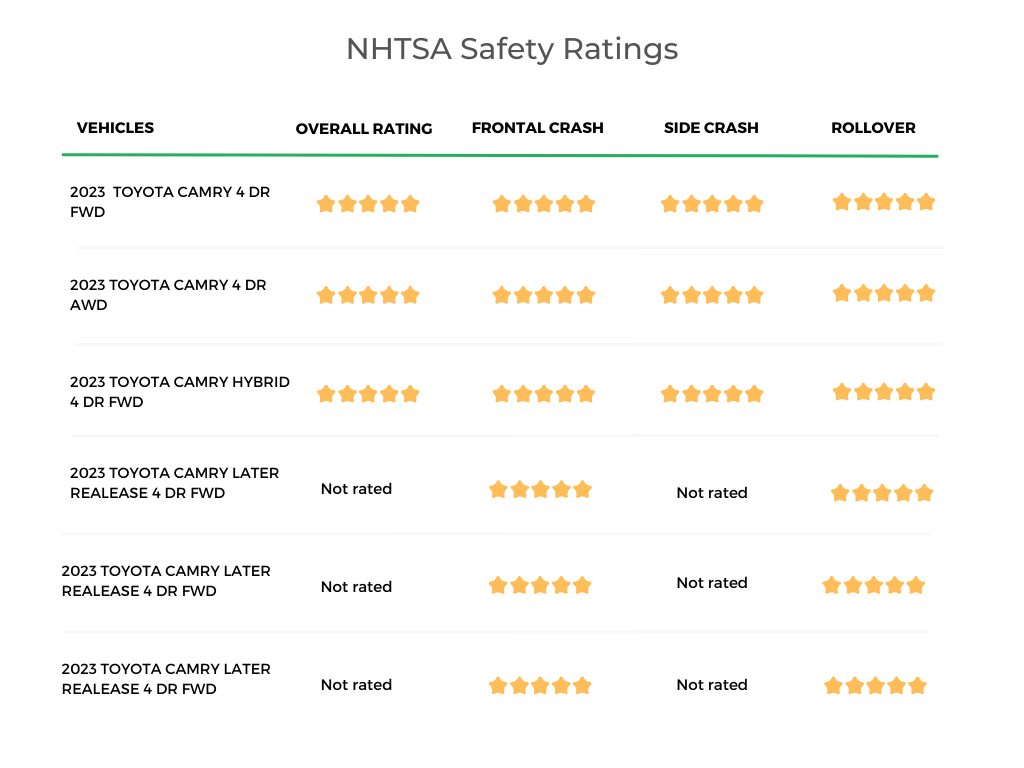
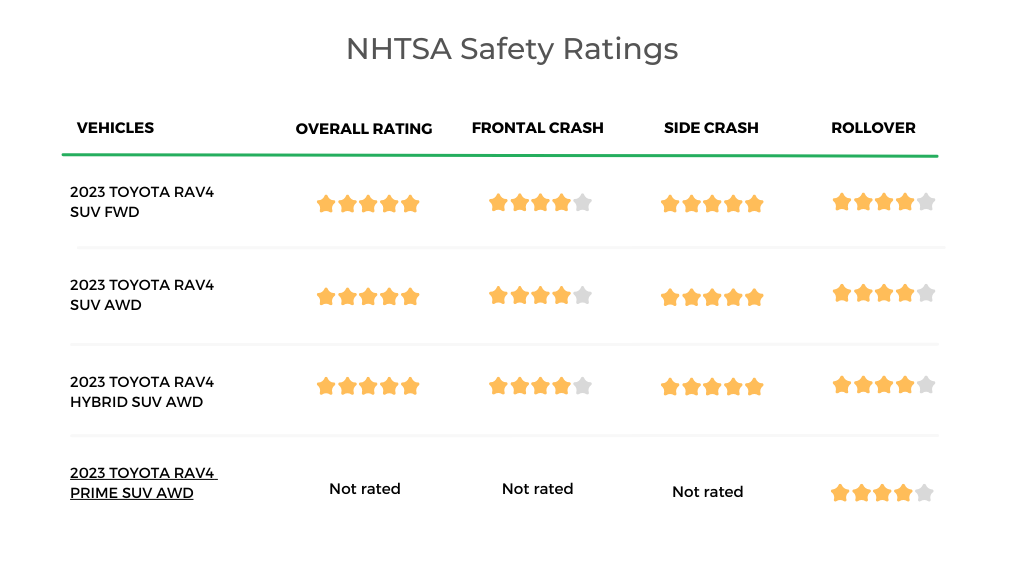
IIHS Awards:
The Insurance Institute for Highway Safety (IIHS) performs crash testing on cars like the NHTSA, but adds in protocols for evaluation of roof strength, head restraints & seats, headlights, and advanced safety nets like automatic emergency braking.
Instead of using stars to rank safety, the IIHS awards ratings of Good (the best), Acceptable, Marginal, and Poor (the worst). For vehicles with exceptionally high testing performance, the IIHS gives out Top Safety Pick (TSP) and TSP+ awards.
As you can see in the chart below, the 2023 Camry is a TSP+, while the RAV4 takes home TSP honors. What’s the difference? To earn the plus sign, a vehicle must have ratings of Good for all crash tests versus the TSP rating that allows for an Acceptable score in the side crash test.
In line with NHTSA testing, these IIHS safety ratings make the point that the 2023 Toyota Camry and RAV4 are very safe vehicles. But, the Camry edges out the RAV4 with the best safety rating.
| IIHS Award | Tested Vehicle | ||
| 2023 Toyota Camry | MIDSIZE CAR / 4-DOOR SEDAN |
2023 TOP SAFETY PICK + |
2018 Toyota Camry LE 4-door |
| 2023 Toyota RAV4 | SMALL SUV /4-DOOR SUV |
TOP SAFETY PICK | 2019 Toyota RAV4 XLE 4-door 4wd |
Airbags & Head Restraints:
It may be easy to take airbags for granted these days due to their widespread use, but it’s worth investigating how widespread that use is in any new vehicle considering how effective airbags are in the event of a crash. And while both the Camry and RAV4 are literally stuffed with airbags, there are some important differences.
The main differentiator is the total number of airbags – 8 in the RAV4 versus 10 in the Camry. Both vehicles have dual front, dual front-side, and full-length side curtain airbags. But the Camry has dual front knee airbags and dual rear seat-mounted side airbags, the latter of which the RAV4 does not offer.
Neither of these Toyotas offers overhead airbags or active head restraints. Overhead airbags are a recent addition to the airbag industry that offer additional head protection, while active head restraints are intended to reduce whiplash in rear-end collisions and are more common on luxury vehicles.
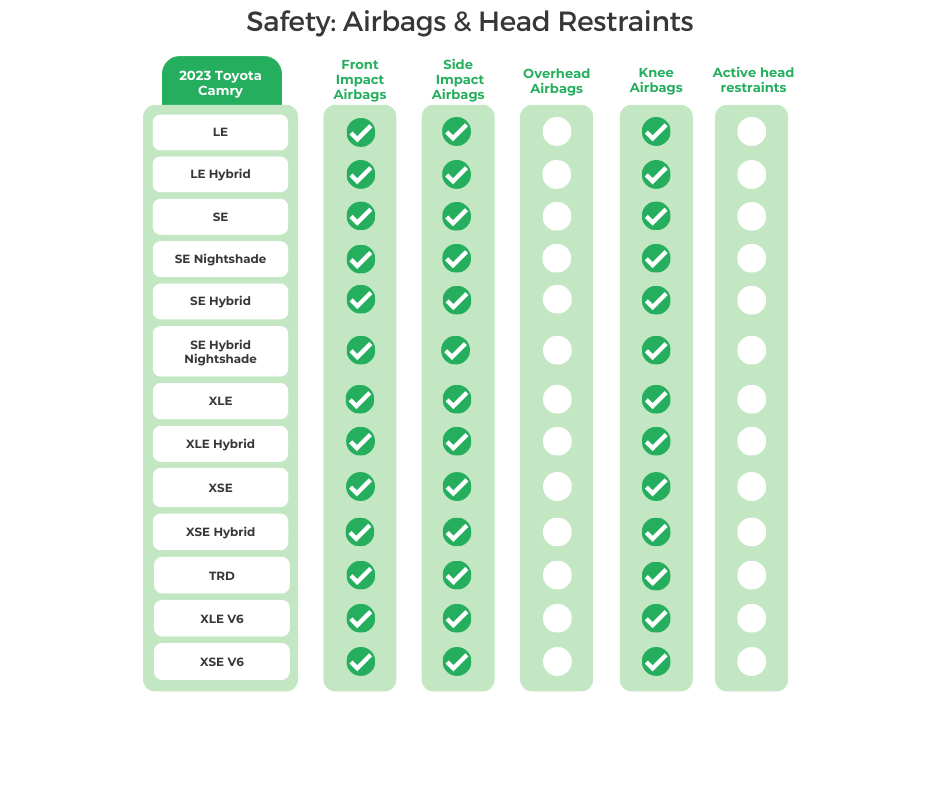
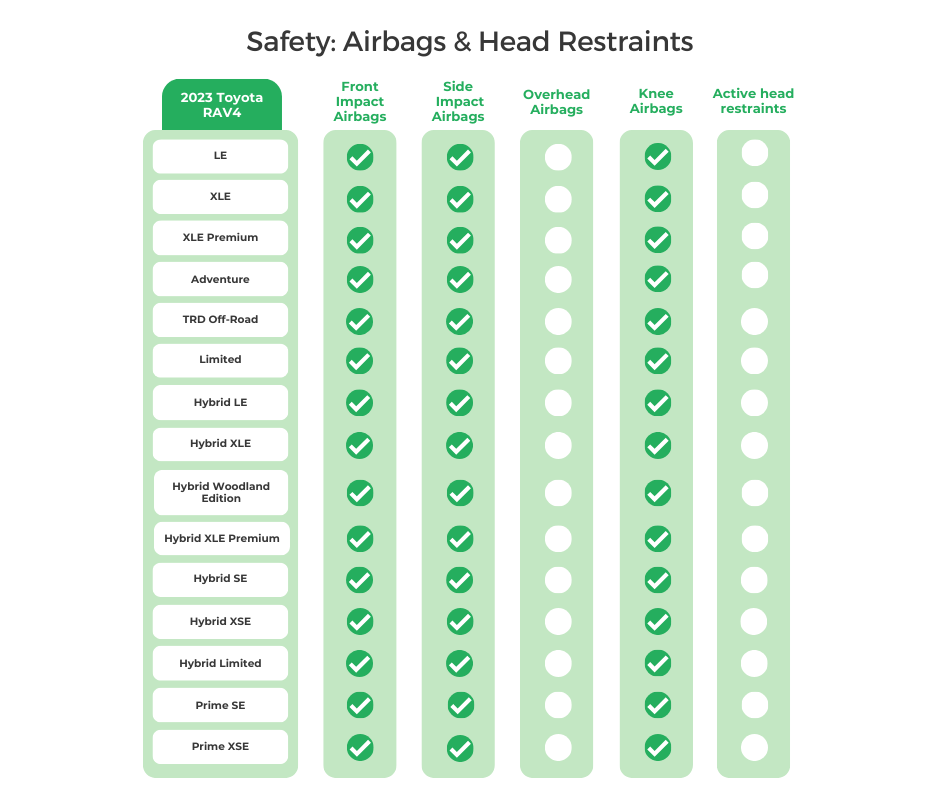
Semi-Autonomous Driving:
You’re not going to find true hands-free driving technology in either the 2023 Toyota Camry or RAV4, but there are a host of standard advanced electronic nannies, I mean ASSISTS, in both vehicles that are designed to reduce the stress of keeping your vehicle on the road all by yourself.
Adaptive cruise control (ACC), which Toyota terms Dynamic Radar Cruise Control, can match your vehicle’s speed to the vehicle in front of you – speeding up and slowing down as needed to maintain a safe distance- but requires your hands to stay on the steering wheel.
When ACC is running, Lane Tracing Assist – also standard across both vehicles – can keep a virtual eye on lane lines and alert you when you’ve ventured too close to those lines. Should you attempt to cross the line without your nanny’s permission, the Lane Departure Alert system can move the steering wheel to keep you, uh, in line.
Both Toyotas also come with a pre-collision system that can warn you of an impending impact and hit the brakes if you don’t respond quickly enough. Sometimes referred to as Forward Collision Mitigation (FCM) it is also intelligent enough to parse out pedestrians from other potential obstacles.
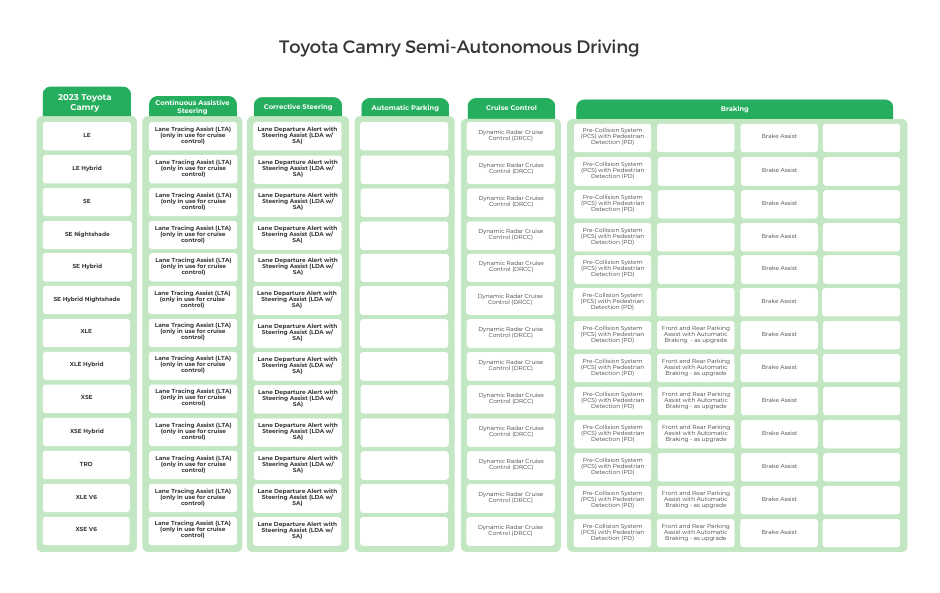
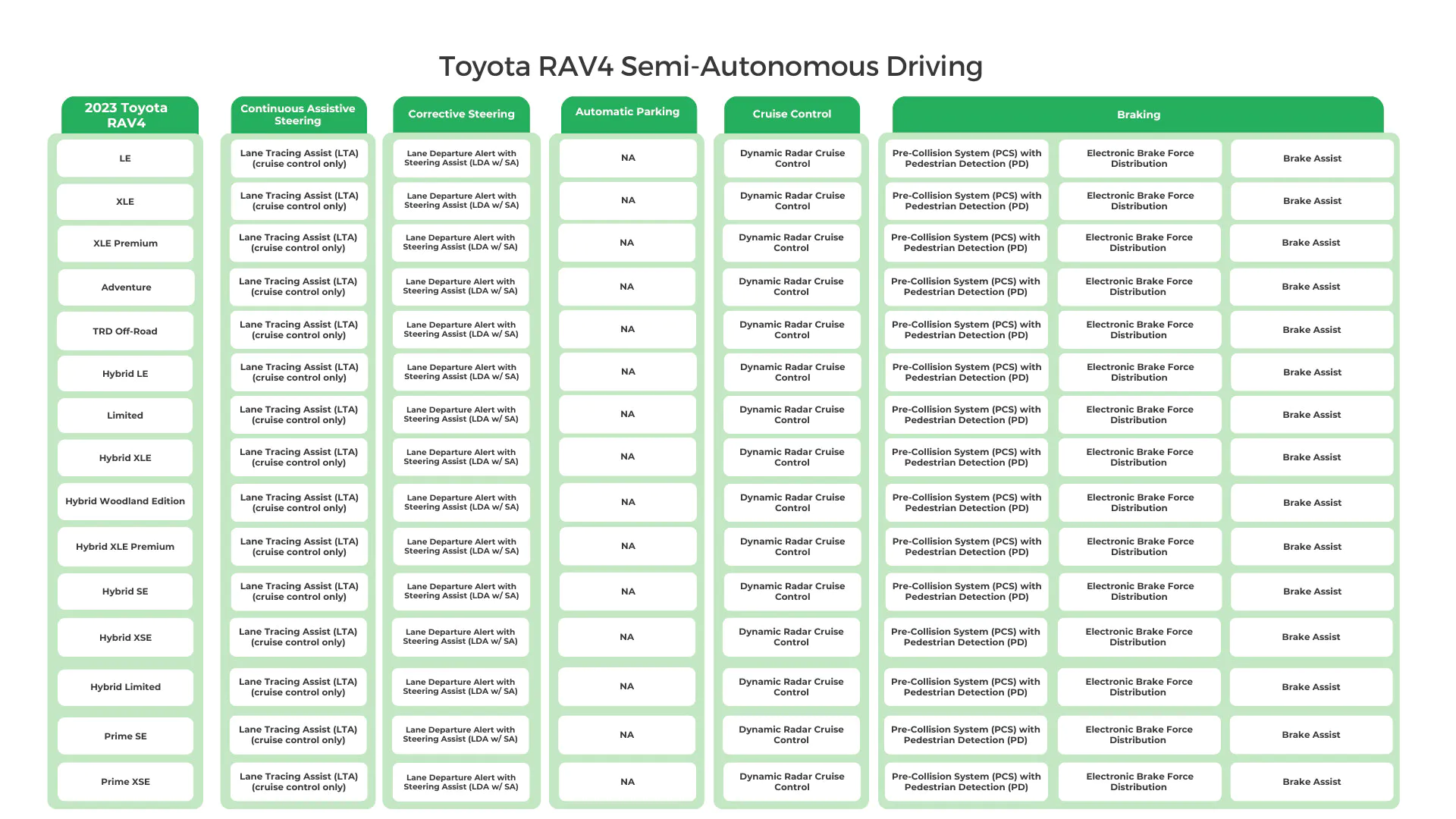
Driver Warning Systems & Telematics:
Along with the aforementioned driver aids, Toyota’s Safety Sense bundle of advanced driver-assistance aids (ADAS) brings a host of additional safety nets to both the Camry and RAV4. Across the board, FCM with pedestrian detection is included as is Road Sign Assist, which displays the details of traffic signs within the instrument panel as you drive past them.
Blind-spot monitoring, which alerts drivers of vehicles sitting in their blind spots, and rear cross-traffic alert, which can detect incoming vehicles from either side while reversing, are not standard on either the Camry or RAV4, but are available on certain trims as outlined in the table below.
While neither vehicle offers Intersection Turn Assistance, a drowsy-driver monitor, or safe exit assistance, the Camry comes standard with Rear Occupant Alert. Unavailable on the RAV4, this system acts as a reminder that there is someone sitting in the back seat, so they don’t get mistakenly left behind.

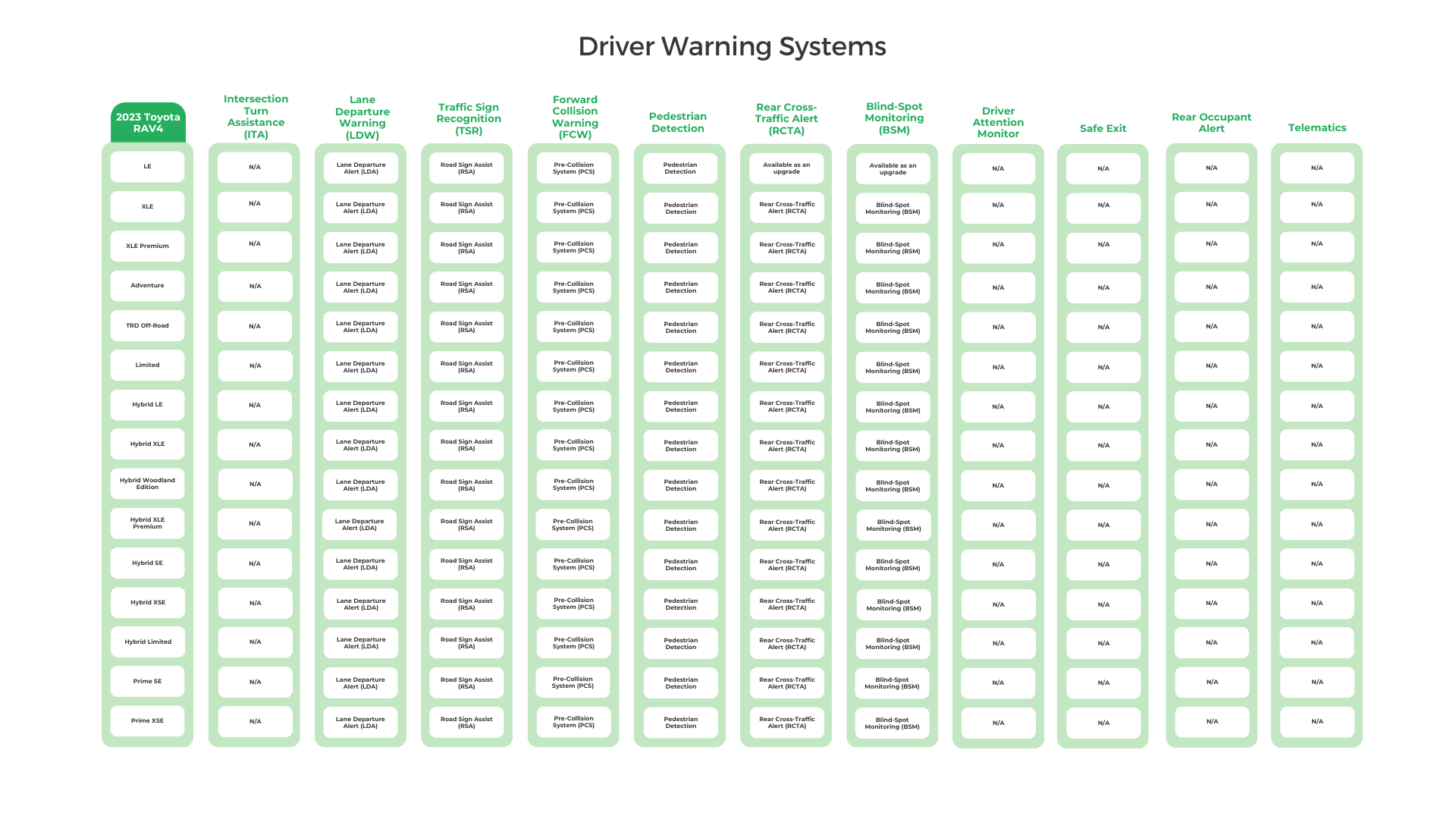
Road Visibility Features:
As with the roster of ADAS discussed above, these Toyotas share several systems related to road visibility. LED headlights, which are the definition of night and day versus old-school halogen bulbs when it comes to visibility at night, are standard on both the 2023 Camry and RAV4.
Adaptive headlights, which rotate the bulbs in concert with steering wheel movement for help seeing around corners, are only available on the Camry in XLE Hybrid trim. However, rain-sensing wipers, which manage wiper speed for you, are available throughout the RAV4 lineup but are not offered on the Camry.
Fortunately, Toyota makes automatic high beams, a system that switches the high beams on and off for you, standard across both the Camry and RAV4 lineups. Backup cameras are also lineup standard as federal law has mandated their use on new cars as of 2018.
Head-up displays, which project information like current speed onto the windshield in the driver’s line-of-sight, are typically reserved for high-end vehicles. However, both the XLE and XSE V6-powered Camrys have it included, while it is only an option on the RAV4 Prime XSE.
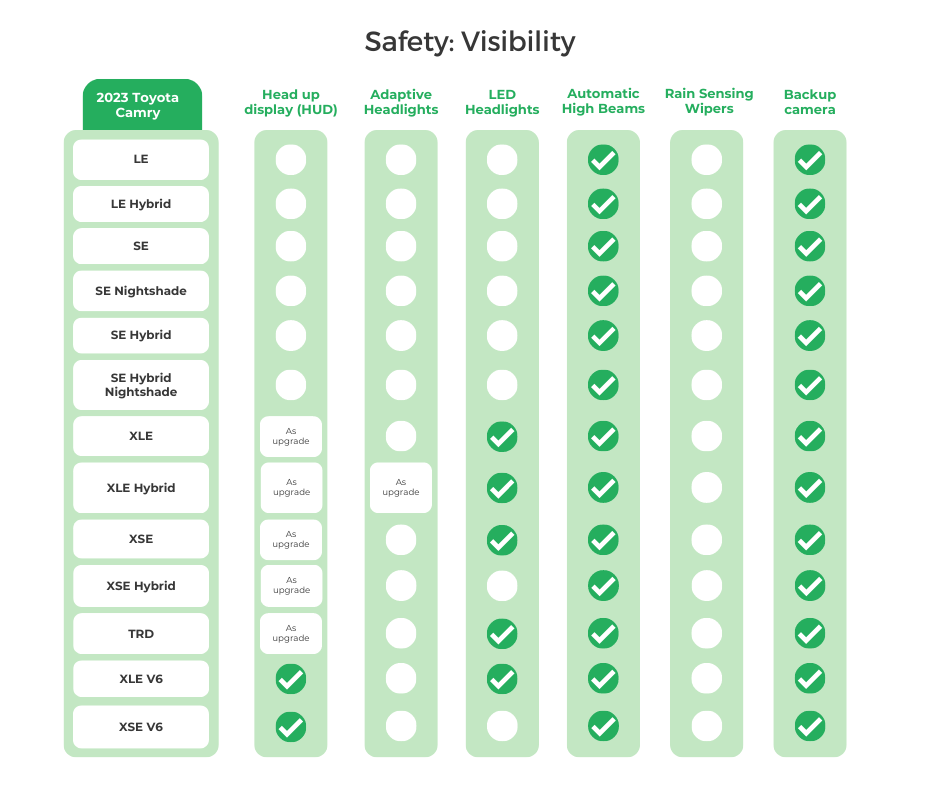
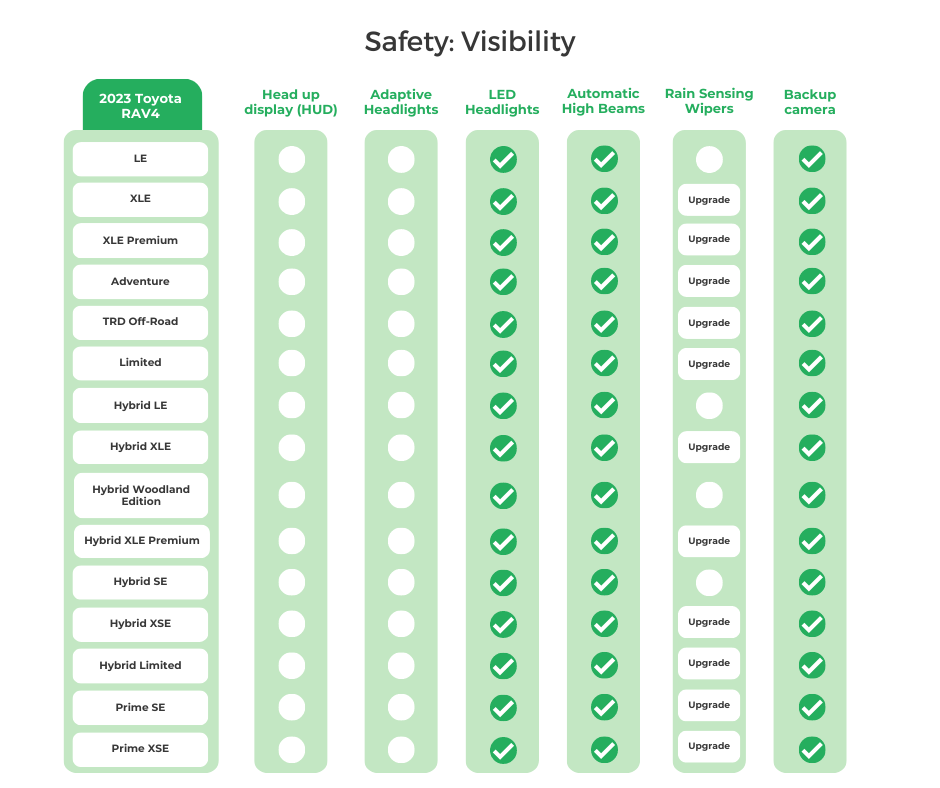
Interior:
Interior Features:
Apple CarPlay and Android Auto, both of which mirror the respective smartphone screens onto a vehicle’s infotainment interface, are extremely widespread systems on new cars. As two of the best-selling vehicles in America, both the 2023 Toyota Camry and RAV4 have these systems included on all models.
Heated seats, which are essential gear for Snow Belt owners, are standard on about half of both the Camry and RAV4 lineups. However, while the RAV4 makes heated seats optional on the rest of its models, certain Camrys like the Nightshade Editions and TRD cannot be fitted with this feature.
If you’re wondering what a heated seats subscription is, you’re not alone as most car buyers are still unaware of these so-called Features on Demand (FOD). But, according to McKinsey, you may want to gain some awareness as the FOD future is coming for the automotive industry.
So far, BMW has experimented with FOD by making heated seats available via subscription with the idea that you only pay for it during cold months. However, that idea flopped as consumer skepticism of vehicle feature subscriptions outweighed BMW’s grand plans. But, you can expect that this new frontier will grow in software-centric aspects of vehicle ownership like autonomous driving and ADAS.

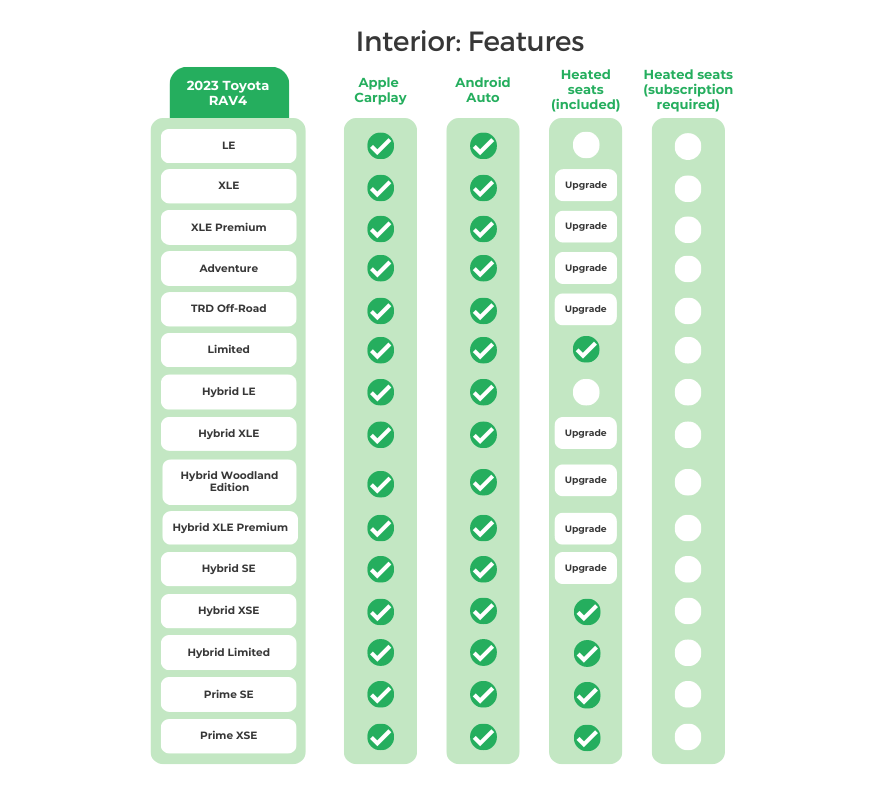
Interior Dimensions:
As platform mates, it’s unsurprising the 2023 Toyota Camry and RAV4 share so many interior dimensions including seating for 4 (comfortably), front headroom, rear legroom, and shoulder room for both rows. As you would expect, the RAV4 trounces the Camry with 40 cubic feet of cargo space to 15.
But the Camry has just a bit – 1 cubic foot – more overall passenger volume and a relative lot more rear hip room – 55 inches to 48 in the RAV4. That’s a metric worth keeping in mind if you plan to tote any rear passengers around as they’ll be less squished in the Camry.
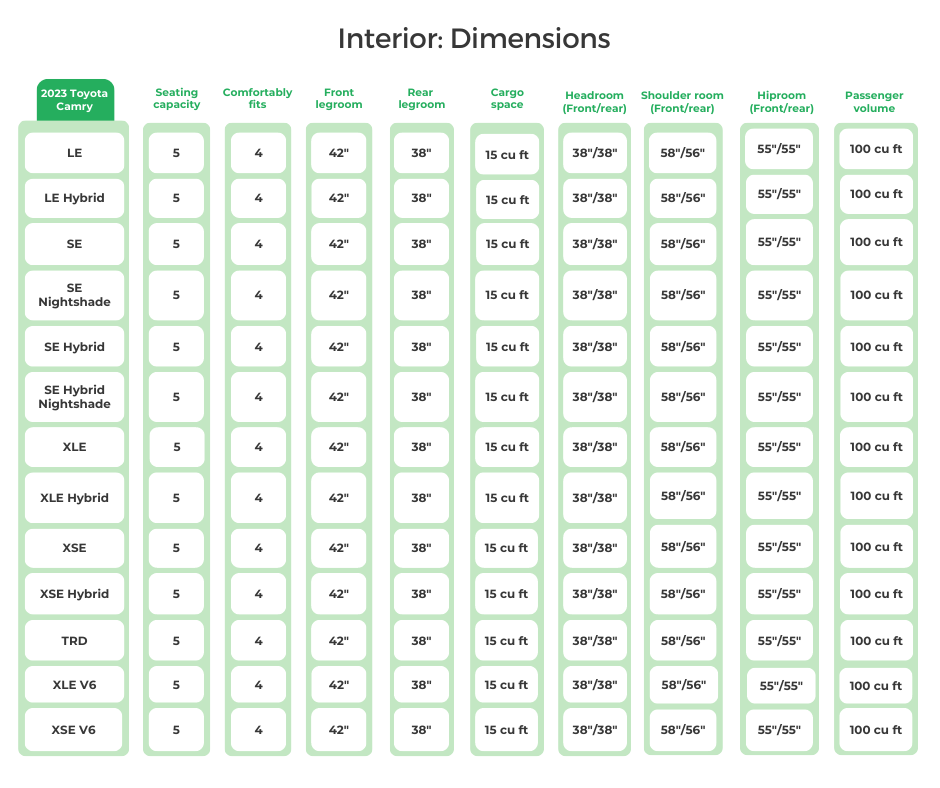
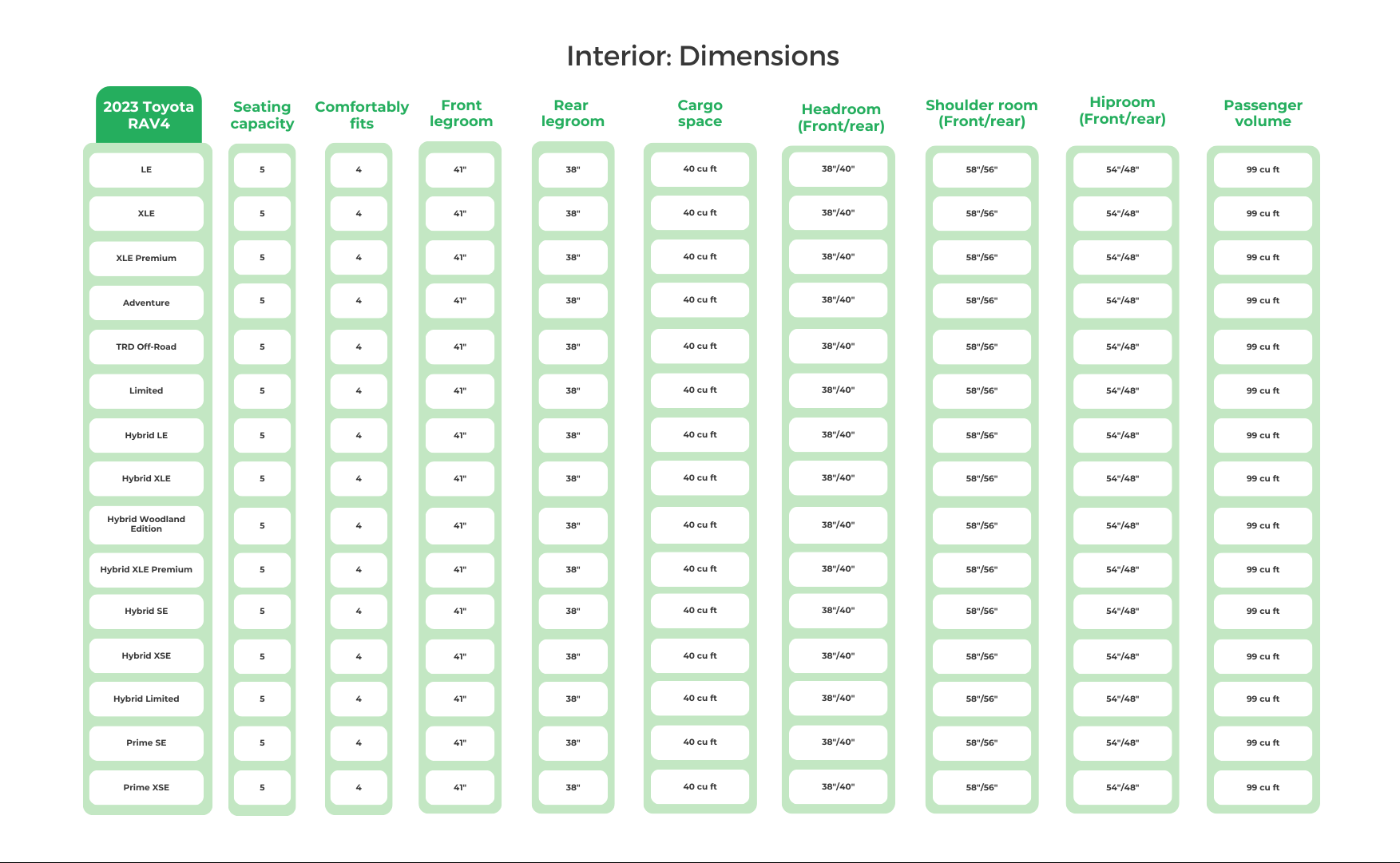
Exterior:
Exterior Features:
It feels strange saying this, but the Toyota Camry is one sweet looking ride. That wasn’t always the case as the recent past saw seas of humdrum beige-colored Camrys roaming the roads. Do you know what color is NOT available on the 2023 Camry? Beige.
Company CEO Akio Toyoda brought this about with his “no more boring cars” decree in 2017 and the Camry has been better for it ever since. Both the Camry and RAV4 offer shades of black, blue, gray, red, and the like on their paint palettes. But only the Camry can be finished in arrest-me Supersonic Red and the sharp Cavalry Blue hue.
And when it comes to wheels, everyone knows bigger looks better even if that means a sacrifice in ride quality. To that end both Toyotas offer up to size 19 with all manner of finishes including black and bronze. But here again, the Camry arguably steals the style cake by offering matte wheel finishes.
Oh yeah, the base RAV4 also comes with steel wheels and hubcaps that won’t be winning any style awards. The Camry? It’s 100% alloy from base to top-spec trim lines.
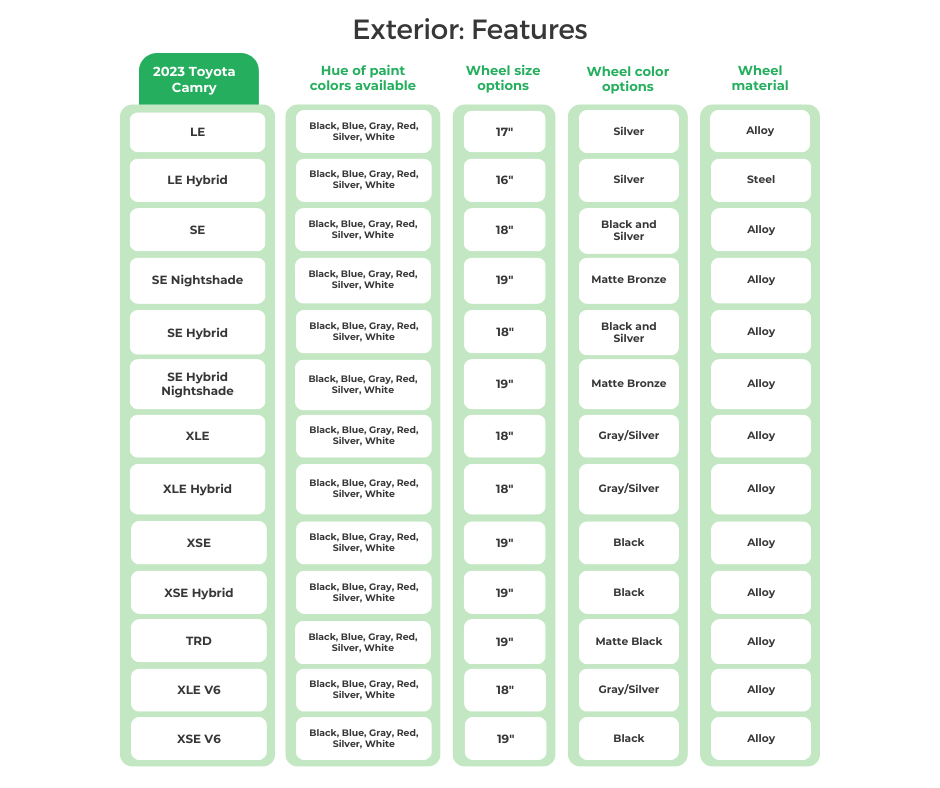
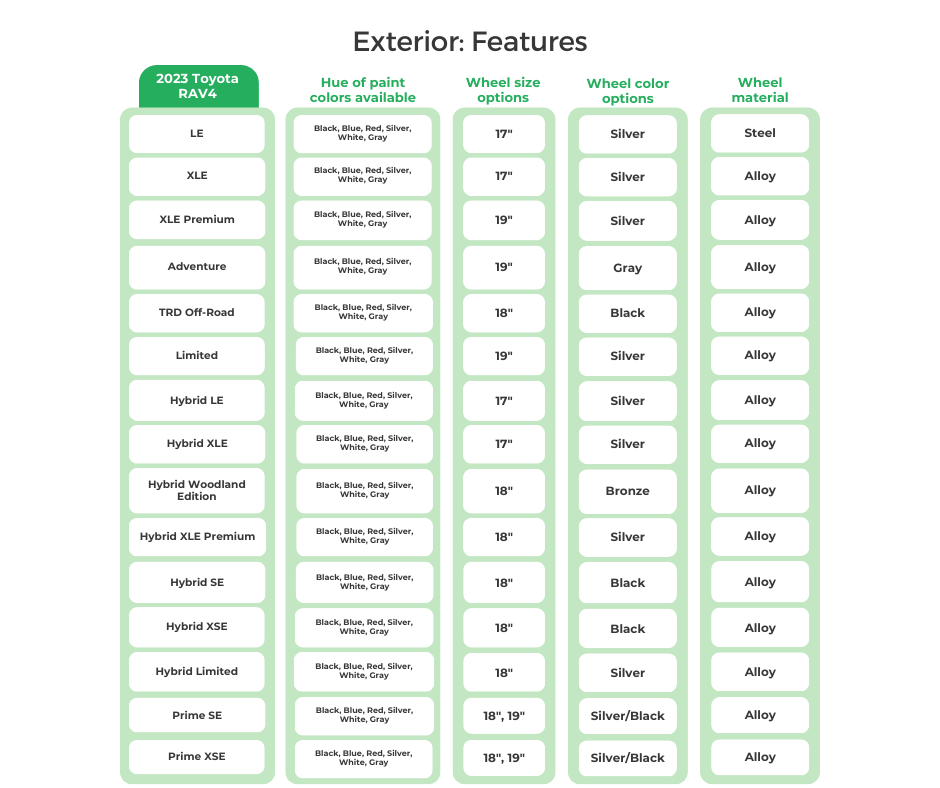
Exterior Dimensions:
Though the Camry and RAV4 share a platform, the 2023 Camry is 11” longer overall than the 2023 RAV4 with a 5” longer wheelbase. That helps explain the slightly better front legroom in the Camry but mostly allows for its competitively sized trunk – for a sedan.
The biggest differentiator in exterior dimensions is that the RAV4 can handle unpaved roads with up to 8.6” of ground clearance. Not that you should be going off-road in a Camry, but just in case you were wondering, it sits nearly 3” closer to the ground, so we don’t recommend it.
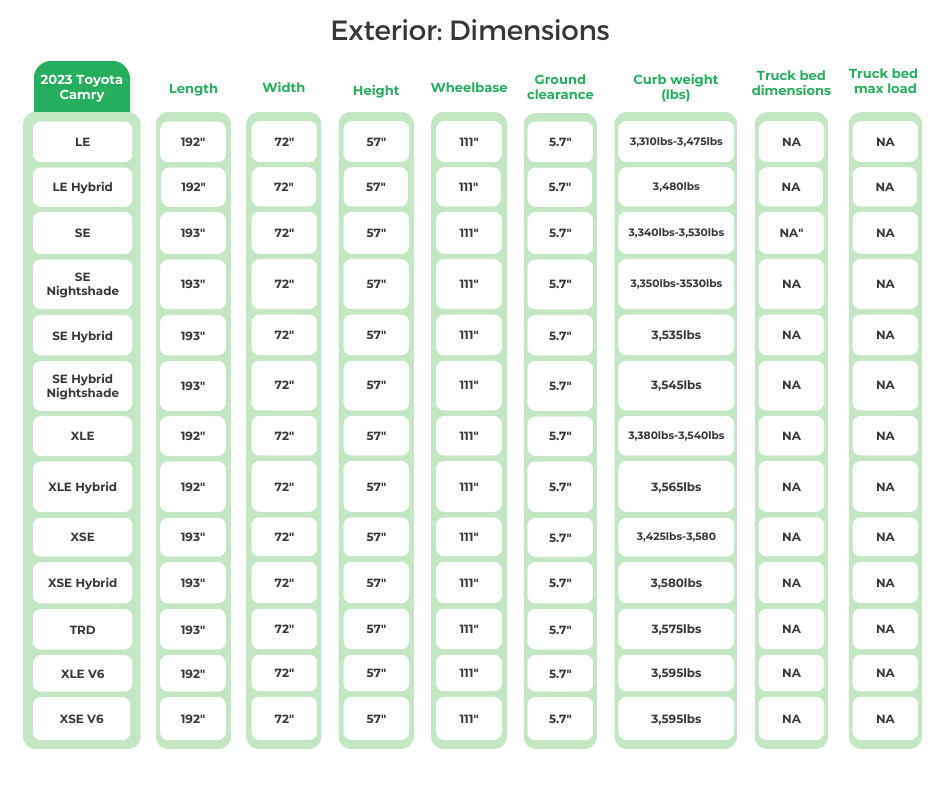
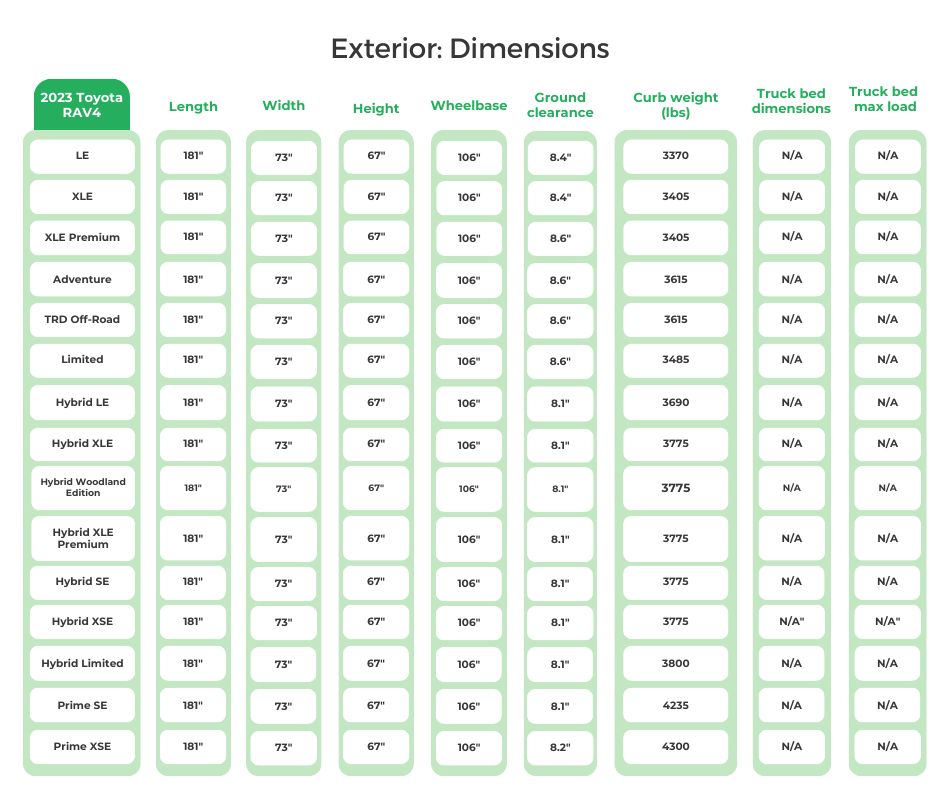
Warranty:
Naturally, the warranty coverage is identical on the 2023 Toyota Camry and RAV4, but just in case you’re cross-shopping a Ford, know that Toyota includes 2 years or 25,000 miles of complimentary service, which Ford cannot match.
Aside from that, it’s the usual mainstream coverage of 3 years or 36,000 miles on the basic bits and 5 years or 60,000 miles on the powertrain. Hybrid battery packs are under warranty for 10 years or 150,000 miles.
| 2023 Toyota Camry Factory Warranty Coverage: | 2023 Toyota RAV4 Factory Warranty Coverage: | |
| Basic warranty: | 36 months/36,000 miles | 36 Months/36,000 Miles |
| Powertrain warranty: | 60 months/60,000 miles | 60 Months/60,000 Miles |
| Corrosion perforation warranty: | 60 months/unlimited miles | 60 Months |
| Air conditioning warranty: | 12 months/12,000 miles (AC recharge) | 12 Months/12,000 Miles |
| Battery warranty: | 120 months or 150,000 miles (Hybrid HV Battery) | 120 months/150,000 miles (Hybrid Battery). Reduction in traction battery capacity for Plug-in Hybrid trims is not covered. |
| Emissions warranty: | Federal: 36 months/36,000 miles (defects) California: 36 months/50,000 miles |
Federal: 36 month/36,000 miles (defect), 24 months/24,000 miles (performance) California: 36 months/50,000 miles (performance) |
| Roadside assistance coverage: | 24 months/25,000 miles (ToyotaCare) | 24 months/25,000 miles |
| Total unique recalls: | 1 (recall no. 23V432000) | 1 (recall no. 23V485000) |
Driver Experience | A Summary of The Top 10 Toyota Camry vs. Toyota RAV4 Reddit Posts:
If it’s owner feedback you seek for the Toyota Camry and RAV4, you’ll find endless insight and opinions over at the What Car Should I Buy Reddit.
Looking over comments comparing these two Toyotas reveals a general consensus that the Camry is more comfortable, particularly for long road trips. As user Pahlevun notes, “A Camry isn’t exciting or particularly fancy, but it is very well built and long-distance driving is its bread and butter.” Sounds about right.
Most others also seem to agree that both Toyotas are well-built and reliable, but when it comes to extra space and driver visibility, the RAV4 is where it’s at. Then again, if it’s fuel economy you’re after, users note the hybrid-powered Camry can’t be beat.
As one user notes, “I’d say the Hybrid Camry is just about the ultimate form of commuter long-distance vehicle.” So, as with any purchase, it all comes down to personal preference, but browsing Reddit is a good place to get unfiltered real-life perspectives and answers to your questions.
Who Should Buy These Cars: The Legacy of The Toyota Camry & Toyota RAV4
| Frequent Use Categories: | Toyota Camry | How Useful? (Out of 5 Stars) | Toyota RAV4 | How Useful? (Out of 5 Stars) |
| Family Vehicle | ***** | ***** |
| Lots of Driving (travel/long commute) | **** | **** |
| Hauling/Towing | * | * |
| Office on Wheels | * | * |
| Sport/Fast Driving | * | * |
| Luxurious Driving | * | * |
| Outdoor/Off-Road | * | * |
The chart above backs up our earlier note around how the Camry and RAV4 are used by their owners. This data comes from survey responses from those owners and as you can see, Family Vehicle is the primary reason for buying both of these cars, followed closely by Lots of Driving.
Given the top safety ratings and above-average fuel efficiency – particularly in a hybrid form – of these Toyotas, this type of owner usage makes sense. One note to keep in mind if you’re aiming to buy a used Toyota RAV4 is to be aware of towing and hauling.
Though the above table doesn’t list this activity as a major use of the RAV4, it can tow up to 3,500 pounds, so it’s worth finding out if the model you’re considering has done any trailering as it tends to have a negative impact on wear and tear. Would-be Camry buyers need not worry as the Camry is not set up for towing.
Year-by-Year Comparison | Toyota Camry vs. Toyota RAV4
Best & Worst Years | Toyota Camry vs. Toyota RAV4 | 2001-2024

This handy graphical representation of the Best & Worst Model Years of the Camry and RAV4 is a reminder that just because it’s a Toyota doesn’t guarantee reliability. Generally speaking, from 2011-2012 forward, you can find a solid option for either vehicle, but watch out for the 2016 RAV4.
If you’re on a tighter budget, the 2002 RAV4 will offer you the cheapest purchase price, but you’re likely in for quite a few miles given it’s more than 20 years old.
The 2008-2009 range is more of a sweet spot for those looking to buy a used Toyota Camry or RAV4 without breaking the bank – which correlates with the Goldilocks zone discussed in the Depreciation section above.
We’ve circled the start of new generations as those model years tend to be accompanied by reliability problems. The yellow sections are marked Undecided as we do not yet have enough FIXD data to make an accurate call on which camp those vehicles fall into.
Important Features Timeline | Toyota Camry vs. Toyota RAV4
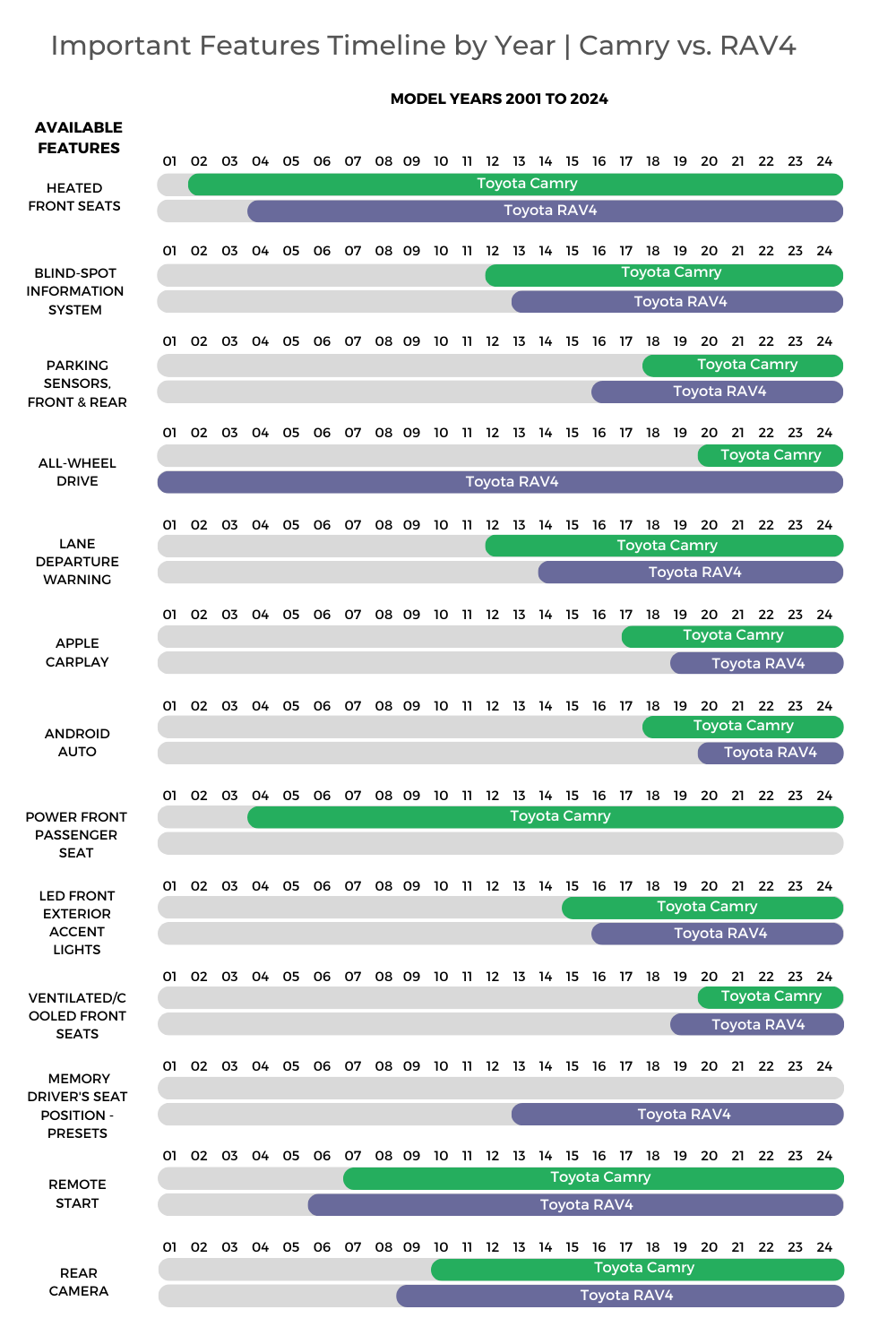
As the Camry and RAV4 are both Toyotas, more recent models have similar levels of key features like the Toyota Safety Sense bundle of ADAS and smartphone mirroring. But, if you’re looking at an older model to purchase, this timeline graphic is intended to help you prioritize model years by which features are most important to you.
Though it’s not on here, we should note that the first year the Camry was offered as a hybrid was in 2007, while the RAV4 didn’t gain a hybridized powertrain until 2016. But, the RAV4 has been offering AWD since 2001 versus 2020 when the AWD Camry arrived.
Both vehicles have offered heated front seats for about 20 years, though Camry was two years earlier on delivering this favorite feature in 2002. Ventilated front seats are a more recent industry amenity and both these Toyotas received this feature within the last couple of years.
Apple CarPlay and Android Auto have been available since 2017-2018 on the Camry and 2019-2020 on the RAV4 with blind-spot monitoring and lane-departure warning going back to the 2012-2014 time frame. The federal government mandated backup cameras in 2018, but Toyota has been putting them in the RAV4 since 2009 and the Camry since 2010.
Maintenance Costs (Year-by-Year Average) | Toyota Camry vs. Toyota RAV4
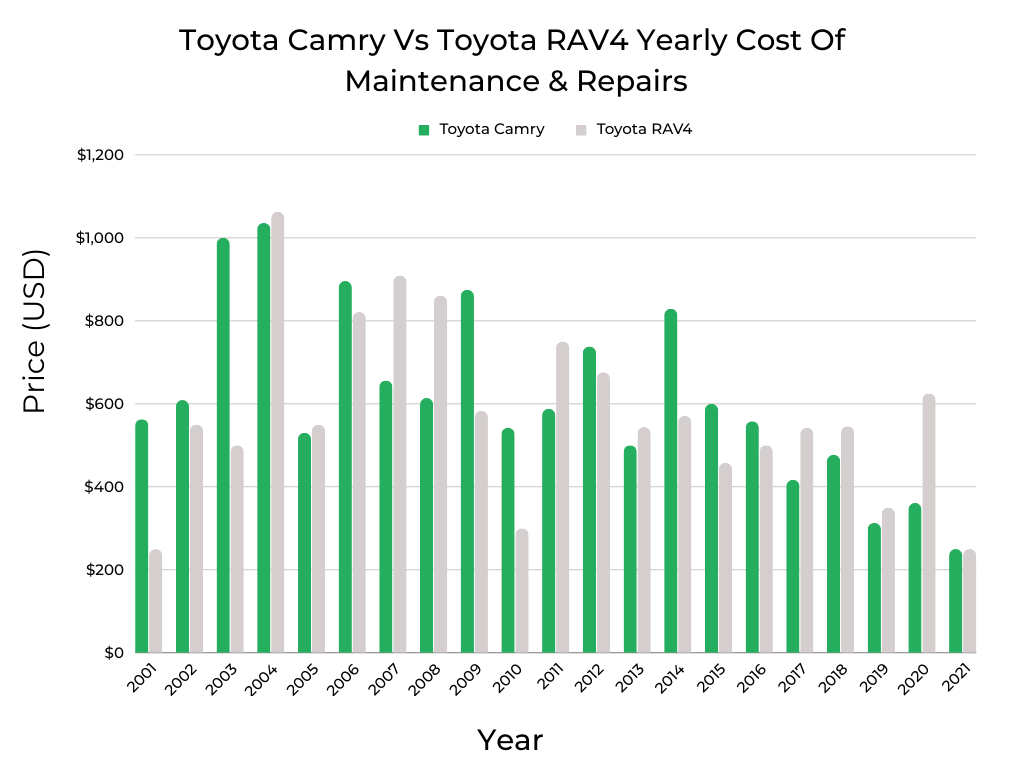
This chart provides an easy way to see how the Toyota Camry and RAV4 compare on annual maintenance costs per owner responses over the last 20 years. While some years show dramatic variation, these two Toyotas are relatively close on an average basis.
Between 2001 and 2021, the Toyota Camry averaged $617 in annual service bills versus the RAV4 which came in a bit lower at $581 for the same range. As you can see, some model years are higher than others and should be watched out for like the 2003, 2004, 2006, 2009, and 2014 Camry.
As for the RAV4, the 2004 and 2006-2008 model years hit or exceeded $800 in annual repair costs, so do your homework before buying. On that note, keep in mind that model year isn’t the only factor in high repair bills. While some owners follow a schedule of regular upkeep, others don’t think twice about driving their cars into the ground.
That’s why it pays to get a hold of service history records before buying any used vehicle including the Camry and RAV4. Our Best & Worst Model Years series for the Toyota Camry and RAV4 provide a deeper analysis of owner-reported maintenance costs.
Safety Ratings Comparison | Toyota Camry vs. Toyota RAV4
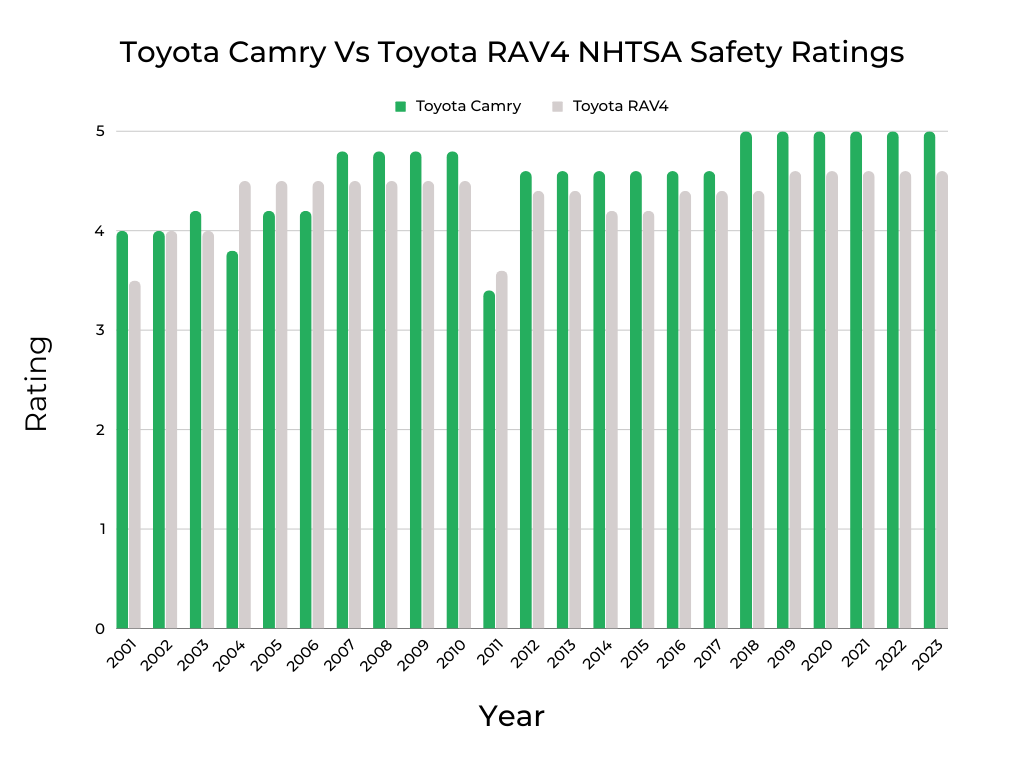
If I sound like a broken record as I regale you with how safe the Toyota Camry and RAV4 are, this chart really drives the point home. Almost every year between 2001 and 2023, these Toyotas earned average NHTSA safety ratings of 4 out of 5 or better. Almost.
The big decline in 2011 is common to the wider U.S. automotive industry as the NHTSA instituted new, more stringent testing protocols that year. The Camry and RAV4 both struggled that year but quickly returned to form the following year.
Other notably poor showings include the 2001 RAV4 and 2004 Camry. Though there is no clear reason behind these lower safety scores, the 2001 RAV4 is on our list of worst model years for this crossover and the 2004 Camry shares that dubious distinction for its worst model years rankings.
Another notable point that shows up here – and keeps the broken record theme going – is that the Camry earns higher safety ratings than the RAV4 18 times out of 23 model years.
Fuel Efficiency Comparison | Toyota Camry vs. Toyota RAV4
If I’m a broken record on Toyota safety, I’m just straight up whining – by which I mean singing Camry’s praises – when it comes to the fuel economy comparison between the Camry and RAV4 as the charts above illustrate so nicely.
The chart on the left, which compares gas-powered efficiency, isn’t as stark as the hybrid version to the right. However, you can see that gas-powered Camrys are largely more stingy with a gallon of gas than the RAV4 as they earn better ratings between 2004 and 2019.
For both vehicles, the ratings increase over time as powertrain technology allows for the more efficient burning of dinosaur fuel. The slight dip in the Camry’s figures in 2017 could be attributed to the EPA updating its testing protocols between 2012 and 2016 that tends to result in reduced MPG metrics.
Over in Hybrid Town, the Camry straight up embarrasses the RAV4, particularly over the past 6 model years. This chart provides a clear visual of how new generations typically bring improved fuel economy as new Camry generations arrived in 2007, 2012, and 2018.
For more insight into fuel economy for these two vehicles, be sure to check out our Best and Worst Model Years series for the Toyota Camry and Toyota RAV4.
Methodology
- Compare two vehicles, Toyota Camry vs. Toyota RAV4, and provide a comprehensive analysis.
- Gather relevant information and data on both vehicles from reliable sources, such as manufacturer specifications, expert reviews, customer feedback, industry reports, and data sources like manufacturer websites, FIXD App, Kelley Blue Book, FuelEconomy.gov, and NHTSA.
- Collect data on various aspects, including performance, safety features, fuel efficiency, maintenance costs, reliability, owner satisfaction, and market value.
- Identify the key criteria that will be used to evaluate and compare the two vehicles.
- Ensure the criteria cover both objective factors (such as performance metrics, safety ratings, and fuel efficiency) and subjective factors (such as owner satisfaction, comfort, and features).
- Assess the performance of both vehicles based on factors such as acceleration, handling, braking, and overall driving experience.
- Compare engine options, horsepower, torque, transmission options, and any unique performance features.
- Examine the safety features and ratings of both vehicles.
- Evaluate crash test ratings, advanced driver assistance systems (ADAS), active and passive safety features, and any notable recalls or known issues related to safety.
- Consider both NHTSA safety ratings and IIHS awards for a comprehensive safety assessment.
- Analyze the fuel economy of both vehicles based on EPA mileage estimates.
- Compare their MPG ratings, average full-tank range, and any significant differences in fuel efficiency.
- Assess the average annual maintenance and repair costs for both vehicles.
- Consider data from surveyed owners and other reliable sources, such as FIXD App owner surveys, to determine the overall cost of ownership over time.
- Evaluate the reliability of both vehicles based on owner reports, FIXD App data, and any known issues or recalls.
- Consider factors such as engine reliability, common problems by model year, long-term durability, and owner reliability scores gathered from surveys.
- Consider owner satisfaction by gathering information from forums, online communities (Reddit: r/whatcarshouldIbuy), customer reviews, and owner reliability scores.
- Summarize key factors that owners appreciate and any common complaints or drawbacks mentioned by owners.
- Compare the features and technologies offered by both vehicles.
- Highlight any notable differences in terms of infotainment systems, connectivity options, driver assistance features, interior quality, and available upgrades.
- Assess the market value and depreciation of both vehicles.
- Compare average prices, resale value, and how the vehicles hold their value over time.
- Consider average private-seller valuations from Kelley Blue Book (KBB) for a comprehensive assessment.
- Summarize the findings of the comparison, highlighting the positives and negatives of each vehicle.
- Provide a fair and balanced recommendation based on the comparison, considering factors such as budget, personal preferences, specific needs of the buyer, and the comprehensive analysis conducted.
Sources:
- KBB Values: Average private-seller valuations as supplied by Kelley Blue Book (KBB), based on a Toyota Camry and Toyota RAV4 with typical mileage for that respective model year.
- Fuel Economy: Mileage-per-gallon estimates according to the EPA MPG on Fueleconomy.gov.
- Annual Maintenance/Repairs: Upkeep expenses as reported by surveyed Toyota Camry and Toyota RAV4 owners.
- Safety Ratings: Crash test data collected and reported by NHTSA. We average all ratings for each year to come up with a simplified, average safety score. This makes it easier to look at on a graph. We also collected IIHS Awards for this article.
- Vehicle Features: Most or all information gathered on vehicle features were from the manufacturer websites, in this case Toyota.com

Niel Stender grew up doing replacement work on his old Cherokee and sweet Mitsubishi Starion, which led to a degree in mechanical engineering and a job at Ford as a vehicle dynamics engineer. His writing infuses that automotive background with sales and marketing experience. Writing about cars for close to a decade now, he enjoys digging into some of the more technical mechanical systems under the hood and throughout a vehicle.

